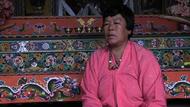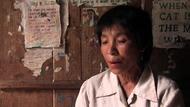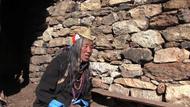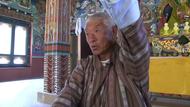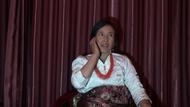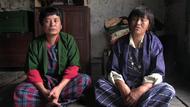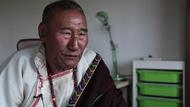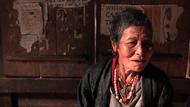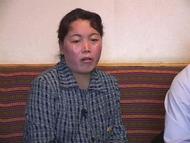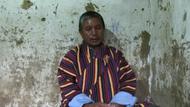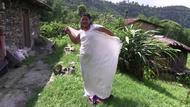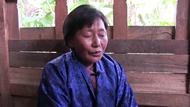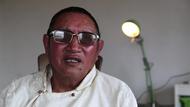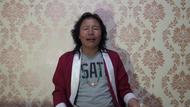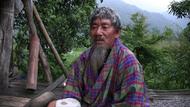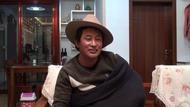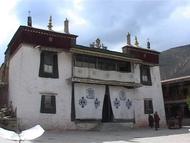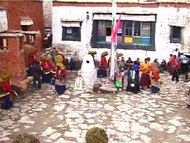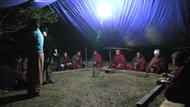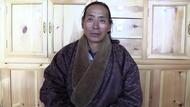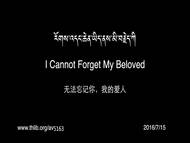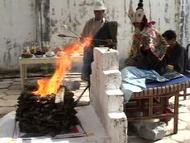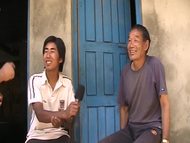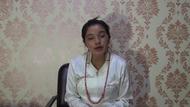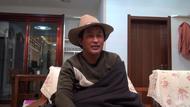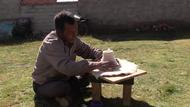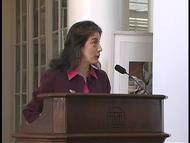Video Overview
An interview with a monk on the history of Drigung Til Monastery.
- Ü
- Drigung Til
- སྐུ་ཞབས་བསོད་ནམས་རིན་ཆེན་ད་ཆོས་ལུགས་ཀྱི་གྲུབ་མཐའ་བཀའ་བརྒྱུད་སྤྱི་ལ་ཆ་མཚོན་བ་ན། ད་རྒྱ་གར་འཕགས་པའི་ཡུལ་ཡིན་ན། གྲུབ་ཆེན་ཏེ་ལོ་དང་ནཱ་རོ།མར་པ། དེའི་ཨ་ནི་ཏེ་ལོ་དང་ནཱ་རོ། ནཱ་རོའི་སློབ་མ་ད་མར་པ། མར་པ་དེ་བོད་ལ་བཞུགས་ནས་ད། མར་པ་ལོ་ཙཱ་བ་ལ་སྒྲ་བསྒྱུར་མར་པ་ལོ་ཙཱ་བ་བྱུང་ནས། ད་བཀའ་བརྒྱུད་གཙོ་བོ་དེ་ནས། ད་མར་པ་རིན་པོ་ཆེའི་སློབ་མ་མི་ལ་རིན་པོ་ཆེ། ད་མི་ལ་རིན་པོ་ཆེའི་སློབ་མ་མཉམ་མེད་དྭགས་པོ་ལྷ་རྗེ། ད་མཉམ་མེད་དྭགས་པོ་ལྷ་རྗེ་ཁོང་རྣམ་པ་ད་བྱོན་ནས་ད་ཚོད་མི་ལོ་གཅིག་སྟོང་ཡན་འདྲ་པོ་དེ་འདྲས་ཤིག རབ་བྱུང་དང་པོའི་ནང་བྱོན་བསྡད་པ་དེ་འདྲས་ཤིགAs for the Kagyu School in general, it came from India through [figures such as] the great saints Tilopa and Naropa, and Marpa. Marpa was Naropa's disciple. The Kagyu School came primarily from Marpa, the Translator, who came to Tibet. Precious Milarepa was a disciple of Marpa. The Incompatible Dagpo Lhaje was Milarepa's disciple. It has been over 1000 years since these [figures] such as Dagpo Lhaje, etc. came. They came in the first Rabjung.
- སྐུ་ཞབས་བསོད་ནམས་རིན་ཆེན་ད་དྭགས་པོ་ཁོ་རང་གི་སློབ་མ་དེ། མཉམ་མེད། དང་པོ། དྭགས་པོ་སློབ་མ་དངོས་གཞི་དེ་ད། ཀརྨ་དུས་གསུམ་མཁྱེན་པས་ཕྱག་བཏབ་པའི་ཀརྨ་ཚང་བཀའ་བརྒྱུད་དང་དར་མ་དབང་ཕྱུག་ཀྱིས་ཕྱག་བཏབ་པའི་འབའ་རོམ་དགོན་པ་དང་། ཞང་འགྲོ་བའི་མགོན་པོས་ཕྱག་བཏབ་པའི་ཚལ་པ་བཀའ་བརྒྱུད་དང་། ཕག་གྲུ་རྡོ་རྗེ་རྒྱལ་པོས་ཕྱག་བཏབ་པའི་ཕག་གྲུ་བཀའ་བརྒྱུད་དང་། ད་དེ་ལ་དངོས་སློབ་བཞི་པོས་ཕྱག་བཏབ་པའི་བཀའ་རྒྱུད།The four main disciples of the Incompatible Dagpo [are as follows]: the third Karmapa Dusum Khyenpa established the Kamtshang Kagyu tradition; Darma Wangchuk established the Barom monastery; Zhang Drowai Gonpo established the Tselpa Kagyu tradition; and Phagdru Dorje Gyalpo established the Phagdru Kagyu tradition. These are the four Kagyu traditions establisehd by the four main disciples.
- སྐུ་ཞབས་བསོད་ནམས་རིན་ཆེན་སྤྱིར་བཏང་བྱས་ན། དེ་འདྲས་གིས་བུ་ཆེན་བཞིས་ཕྱག་བཏབ་པའི་བཀའ་རྒྱུད་ཆེན་པོ་བཞི་དང་། དེའི་གཞུག་གུ་ལ་ད་ཕག་གྲུའི་སློབ་མ་འགྲོ་བདག་ཁྲོ་ལེན་གྱིས་ ད་ཕག་གྲུའི་དངོས་སློབ་དངོས་སུ་ད། དེའི་སློབ་མའི་ནང་ལ་སྐྱོབ་པ་འཇིག་རྟེན་གསུམ་གྱི་མགོན་པ། ཁོ་རང་གི་ཨེ་ད་ཐུན་མོང་མ་ཡིན་པའི་འབྲི་གུང་དགོན་པ་ཕྱག་བཏབ་ནས། ད་ལོ་མི་ལོ་བརྒྱད་བརྒྱ་གཉིས་ཤུ་རྩ་དགུ། ད་གཅིག་སྟོང་གཅིག་བརྒྱ་དོན་ཅུ་དོན་དགུའི་ལོ་ལ་ཕྱག་བཏབ་པ་རེད། དེ་འདྲས། བརྒྱད་བརྒྱ་གཉིས་ཤུ་རྩ་དགུ་ལ་དགོན་པ་འདི་ཕྱག་བཏབ་ནས་ད་བར། ལོ་ལ་བྱས་ན། ཨ་ནི་དེ་འདྲས་ཞིག་རེད།{note: the first line of this section should be moved to the previous section.} So, in general these are the four major Kagyu traditions established by the four great disciples. And later, {note: this passage is a quote. someone should check with it.} Kyoppa Jigten Sumgyi Gonpo, a main disciple of Phagdru established Drigung monastery, a unique monastery. Now it has been 829 years since it was established. It was established in 1179. 829 years is how long it has been since the monastery was established. Okay.
- སྐུ་ཞབས་བསོད་ནམས་རིན་ཆེན་དེ་ཡིན་དུས་ད། སྐྱོབ་པ་འཇིག་རྟེན་མགོན་པོ་དང་པོ་འདིའི་ཡ། སྔོན་ལ་འབྲི་གུང་ཕྱག་བཏབ་ཕེབས་ནས། ད་བྲག་རིན་ཆེན་སྤུངས་པ་དང་བྲག་ལ་ཀ་ཆུང་ཕར་ལ་བཞུགས་གནང་། ཁོང་གཉིས། ཨ་ནི་དེ་ནས་གཅིག་གི་ལྷ་ཡུལ་སྟེང་ཕྱིན་པ་ཁོ་ཚེ་ཕྱི་མ་ངན་སོང་མ་ལྷུང་བ་དང་ད་ནི། ཆོས་སྒྲ་ལྷ་ཡུལ་སྟེང་དུ་སྒྲོགས་པ་དང་དེ་ནས་ནུབ་ཀྱི་་་་་་་ཆོས་ལུགས་ཀྱི་མཛད་སྒོ།{note: can't make anything out of this.}
- སྐུ་ཞབས་བསོད་ནམས་རིན་ཆེན་དབྱར་ཆོས་དང་དགུན་ཆོས་ད་དེ་འདྲས་གཞུང་མང་པོ་གནང་བྱས། རིམ་པ་བཞིན་དུ་ཆོས་ཁང་ནང་སྒྲོགས་པ་སོགས་མཛད་ནས་ད། དེ་འདྲས་དང་ཁྱད་པར་ཐུན་མོང་མ་ཡིན་པའི་གཅིག་གི་སློབ་མ་རྣམས་ཀྱི་གྲུབ་རྟགས་བསྟན་པ་སོགས་མཛད་པའི་སྐབས་སུ། ད་གཅིག་གི་ད་ཚོད་གཉེན་གནས་རིན་ཆེན་གྲགས་ཀྱི་སྐུ་གདུང་དེ་གཉིས་གཅིག་པོ་མ་སྦྱངས་ཚུལ་འཛིན་དེ་བཏོར།(note: no trans.)
- སྐུ་ཞབས་བསོད་ནམས་རིན་ཆེན་དེ་ཁོང་གིས་གསུངས་མགུར་སོགས་དེ་འདྲས་བཀའ་ཆོས་མང་པོ་གཅིག་གསུངས་གནང་ནས། ང་ཚོའི་སྐད་མ་སོང་ནའི། ད་དེ་དངོས་གྲུབ་་་་་་་་་་་་་རིན་ཆེན་གྲགས་ཟེར། ད་དེ་ནི་མ་ཚང་ཚིག་མང་པོ་གཅིག་ཡོའོ་རེད་པཱ། ད་རེ་རེ་ཁ་གཏུག་ལ་སྐྱོར་དགོས་ན་མང་པོ་གཅིག་རེད། ད་སེམས་གྲུབ་ན་བླ་མའི་ཐུགས་ཀ་ཕོག་ཟེར། དེ་ནི་གཅིག་གཅིག་པོར་སྦྱངས་ནས་ད་ལྟ་གཏན་ཆགས་ཟེར་སྐད་གྲགས་ཆེན་པོ་བྱུང་པ་རེད་པཱ། ད་ང་ཚོས་རྒྱ་གར་བསིལ་བ་ཚལ་གྱི་དུར་ཁྲོད་དང་དབྱེ་བ་མ་མཆིས་པ་རེད་ཟེར། དེ་འདྲས་ཟེར་ད་འཛམ་གླིང་ཐོག་དེ་རུ་སྐད་གྲགས་ཆེ་ཤོས་དུར་ཁྲོད་གཅིག་རེད།(note: no trans.)
- སྐུ་ཞབས་བསོད་ནམས་རིན་ཆེན་དེ་འདྲས་རེད་ཟེར་ད་སྨོན་ལམ། དེ་འདྲས་བྱས་བྱས་དེའི་སྐབས་སུ་ཡིན་ན། ཁོང་རང་གི་དེའི་འོག་ལ་ངན་སོང་འཇོམས་ཡས་ཀྱི་ད་ང་ཚོའི་སྐད་ན་ད་མ་སོང་ན་ཆོ་ག་དཀྱིལ་འཁོར་གྱི་དེ་འདྲས་ཀྱི་བྱིན་རླབས་མཛད་ནས། ཟག་ཕུང་དེའི་སྟེང་དུ་སོང་ན་ངན་འགྲོར་ལྷུང་གི་ཡོའོ་རེད་ཟེར། དེ་འདྲས་བྱིན་གྱི་རླབས་པ་སོགས་ད།(note: no trans.)
- སྐུ་ཞབས་བསོད་ནམས་རིན་ཆེན་ཨ་ནི་གཅིག་གི་ཚད་མས་ཡིད་རང་བཞིན་རྟོགས་པ་རྒྱ་གར་བསིལ་བ་ཚལ་གྱི་དུར་ཁྲོད་་དུ་ཡེ་ཤེས་མཁའ་འགྲོ་རྣམས་ཀྱི་འོད་ཟེར་གྱི་དྲྭ་བར་བྱོན་ནས་གདན་འདྲེན་ཞུས་པ་སོགས་ཀྱི་ལོ་རྒྱུས་དང་། དེས་མ་ཚད་པའི་ཕྱིས་སུ་ཨ་ནི་ཀརྨ་དུས་གསུམ་མཁྱེན་པ། འབྲི་གུང་ལ་ཕེབས་ནས། གྲུབ་ཐོབ་དབུས་གསལ་པ་དང་ཉག་སྲས་དབུ་སྣ་དྲངས་ནས་འདི་ལ་གྲུབ་ཐོབ་མཁས་བཙུན་མང་པོ་འདུས་སོང་བ། དབུས་གསལ་ཁོང་དེའི་ཕེབས་ནས། དངོས་སུ་གཅིག་གི།(note: no trans.)
- སྐུ་ཞབས་བསོད་ནམས་རིན་ཆེན་ཨོང་ད། ད་གཅིག་འཁོར་ལོ་བདུན་པའི་ཕོ་བྲང་དེ་ཉིད་དབྱེར་མ་མཆིས་པའི་བསྟན་ཆགས་དེ་ཉིད་གཅིག་གི་མཚན་སྙན་གྲགས་པ་དང་གཏུམ་སྐྲག་ཅན་དང་ད་དེ་འདྲས། སོགས་དེ་འདྲས་ད་རྒྱ་གར་གྱི། ག་རེ་རེད། ད་དུར་ཁྲོད་དབྱེར་མ་མཆིས་པའི་སོགས་དེ་འདྲས་ད་སྐྱེས་ཆེན་དུ་མས། ཨོང་དེ་འདྲས་ཀྱི་གཟི་རྔམས་ཕུན་སུམ་ཚོགས་པ། ད་རྦད་དེ་བསྟན་ཆགས་དེ་འདྲས་ཡོའོ་རེད་པ་ལ། ཨ་ནི་དེ་འདྲས་ད་དེའི་ཚུར་ཁང་འོག་དེ་ད་འབྲི་་་་་་་འབྲི་གུང་སྐྱོབ་མགོན་ཆེ་བ་དང་ཆུང་བ་རྣམ་པ་གཉིས་ཀྱི་གཟིམ་ཆུང་ད། ཨ་ནི་གླིང་གི་ནུབ་ཀྱི་ད་མཐུ་དབང་ལ་རེད་པ་ལགས།(note: no trans.)
- སྐུ་ཞབས་བསོད་ནམས་རིན་ཆེན་ད་འདིའི་རྟེན་འཛམ་གླིང་རྒྱལ་མཚན་བཞུགས་ནང་བཞིན། སྐྱོབ་པ་འཇིག་རྟེན་མགོན་པོ་དང་གཅུང་རིན་པོ་ཆེའི་གདུང་རྟེན་ཡོད་པ། འོ་དེ་འདྲས་ཤིག་ད། ད་གསེར་ཁང་སྐྱོབ་པ་རིན་པོ་ཆེ་ཁོང་ནི། ད་སྔོན་མ་ལྔ་བཅུ་ང་དགུའི་གོང་བཞུགས་ནས་ད་གཅིག་གི་དེའི་རྗེས་དེ་བར། སྐུ་གསུང་ཐུགས་རྟེན་གྱི་ད་གཅིག་གི། དེ་ཚོ་ད་ང་ཚོས་ད་ལྟ་དྲན་ཐུབ་ཡས་ད་དཔོག་ཐུབ་ཡས་ཡོའོ་མ་རེད་དའི། ད་ལྟ་བཞུགས་པའི་ཁོ་རང་གི་སྐོར།(note: no trans.)
- སྐུ་ཞབས་བསོད་ནམས་རིན་ཆེན་སྐྱོབ་པ་རིན་པོ་ཆེ་འཇིག་རྟེན་གསུམ་གྱི་རྟེན་གཙོ་སྐྱོབ་པ་རིན་པོ་ཆེ་དབུས་པས་གཡས་ལ་སྤྱན་མངའ་དང་གྲངས་ཆུང་ཡང་བཀའ་བསྟན་འགྱུར་སོགས་ད་དེ་འདྲས་དང་། འབྲི་གུང་གི་ཐུན་མོང་མ་ཡིན་པའི་དེ་འདྲས་བཀའ་འབུམ་རྣམ་པ་དེ་འདྲས་རོབ་བསྡུས་བྱས་ད། ཨ་ནི་དེ་གདུང་རྟེན་དེ་ང་ཚོ་སྒོ་མང་ནང་ལ་ཆ་མཚོན་ན། ད་གཟོད་ད་གཙོ་བོ་སྐྱོབ་པ་རིན་པོ་ཆེ་དང་། ཆོས་རྗེ་བླ་མ་དང་།(note: no trans.)
- སྐུ་ཞབས་བསོད་ནམས་རིན་ཆེན་ཨ་ནི་དེ་ནས་འབྲི་གུང་གདན་རབས་བཅོ་ལྔ་པ་ཀུན་དགའ་རིན་ཆེན་གྱི་གདུང་རྟེན་དེ་གཉིས་ད། ད་དེ་ནས་དཔལ་འཛིན་རིན་པོ་ཆེ་ད་ལྟ་དངོས་སུ་དགོན་པ་ནས་བརྒྱད་ཅུ་གྱ་གཉིས་ཚུན་ནས་ཆོས་དད་རང་མོས་སོང་ཙང་། དགོན་པ་ནས་སླར་བཟོ་ཐུབ་པ་དཔལ་འབྱོར་རིན་པོ་ཆེ་ཁོ་རང་གི་འདྲ་སྐུ། སོགས་ད་དེ་འདྲས་ཤིག་ལོ་རྒྱུས་འདྲ་ཞིག་དེ་འདྲས་ཤིག་ད།(note: no trans.)
- སྐུ་ཞབས་བསོད་ནམས་རིན་ཆེན་ད་ཨ་ཕྱི་ཁང་གཙོ་བོ་དེ་ད་ལྟ་རྩེ་ལ་གཅིག་གི་རྡོ་རྗེ་བཞེངས་བྱས། ཏེ་ལོ་ནཱ་རོ་མར་པ་མི་ལ་དེའི་རྗེས་ལ་རྡོ་རྗེ་འཆང་། དེའི་འོག་ལ་དྭགས་པོ་ལྷ་རྗེ། ཕག་གྲུ། རྟེན་གཙོ་བོ་དེ་སྐྱོབ་པ་འཇིག་རྟེན་མགོན་པོ། ཨ་ནི་དེའི་སྒང་དེར་ཆ་མཚོན་གཅིག་གི་ཡིད་དམ་འཁོར་ལོ་བདེ་མཆོག དེའི་མར་འོག་དེར་སྐྱོབ་པ་དཔལ་ཡེ་ཤེས་མགོན་པ་ཕྱག་བཞི་པ་རྟེན་གཙོ་ཨ་ཕྱི་ཆོས་ཀྱི་སྒྲོལ་མ་ཚེ་རིང་མ་་དེའི་འོག་ན་ཨ་ནི་རྣམ་སྲས། དེའི་ད་ཐུན་མོང་མ་ཡིན་པའི་འབྲི་གུང་གི་རྟེན་གཙོ་སོགས་དེ་འདྲས་ཀྱི་བཞུགས་བསྡད་པའི་ད་དེ། འབྲི་གུང་གི་ཅི་ཟེར་དགོས་རེད། ད་མགོན་ཁང་ཟེར་དགོས་རེད་དེ་འདྲས་ཤིག།(note: no trans.)
- སྐུ་ཞབས་བསོད་ནམས་རིན་ཆེན་ཨ་ནི་དེ་ནས་ཕར་སྐྱོབ་པ་རིན་པོ་ཆེ་བ་ལ་དཀར་ཆུང་ཟེར་ད་གཟོད་གཅིག་དེ་འདྲས་གཅིག་དངོས་ཡོད་དགོན་པ་ད་ད་གཟོད་ད་གྲྭ་པ་ཞལ་གྲངས་སྤྱིར་བཏང་ཚད་གཞི་བྱས་ནས་ད་གཉིས་བརྒྱ་བཅུ་མེད་ལྔ་ཡོའོ་རེད་ཡིན་ནའི་ད་གཟོད་དངོས་གཞི་བརྒྱ་དང་ལྔ་བཅུ་ཙམ་དེ་འདྲས་ཅིག་བཞུགས་བསྡད་ཡོད། ད་ཆོས་ལུགས་བྱེད་སྒོའི་ཐོག་ལ་བཤད་ན། དགོན་པ་འདི་ལ་གཅིག་གི་སློབ་སྦྱོང་གནང་ཡས་ད་སྤྱིར་ཐུན་མོང་མ་ཡིན་པའི་འབྲི་གུང་ལ་ཆ་མཚོན་ན་དེ་ཉིད་ཁོང་ལ་ཆུད་པ་བྱེད་དགོས་རེད་ལ། ཐུན་མོང་གི་དབང་དུ་བྱས་ན་ད། ཨེ་གཅིག་གི།{note: the first line is not clear.} As for the limit for the number of monks, it is 205. But there are around 150 monks at the monastery. As for carrying out religious activities, [the monks] study {note: can't translate} that are unique to Drigung tradition. As for the study of those that are common to [other traditions], {note: i think this part can go with the next sentence.}
- སྐུ་ཞབས་བསོད་ནམས་རིན་ཆེན་མདོ་དང་མདོ་རྩ་འདུལ་བའི་སྡེ་སྣོད་ མཛོད་དང་སྡེ་སྣོད་མངོན་པའི་སྡེ་སྣོད་ རྩ་འཇུག་གཞི་འཇུག་ཟབ་མོ་ལྟ་བའི་གཞི། བྱང་ཆུབ་དང་ང་རྒྱལ་ཞི་གསུམ་ལུང་དང་བཅས་པ་སྐབས། ཨ་ད་རྒྱན་དྲུག་ཕྱོགས་གཉིས་ཀྱི་དགོངས་འགྲེལ་དེ་འདྲས་རྒྱ་གཞུང་པུསྟི་གསུམ་མཁས་འཇུག་གཞན་པའི་ད་འགྲེལ་པའི་ཐོག་ནས། འཆད་ཉན་ཤེས་མཁན་གྲྭ་པ་གཉིས་ཤུ་ཙམ་ཞིག་ད། དེ་ནས་འབྲི་གུང་ཐོན་མོང་མ་ཡིན་པའི་ལམ་བཟང་མོ།{note: this is a quote which list the 13 texts that they study. check with the quote.} These are the 13 volumes of texts composed by the Six Ornaments and Two Supremes. There are around 20 monks who study these. {note: the last segment can go with the next sentence.}
- སྐུ་ཞབས་བསོད་ནམས་རིན་ཆེན་སྔགས་པ་དང་ཆོས་སྒྲུབ་་ཉམས་ལེན་བྱེད་མཁན་སྒྲུབ་གྲྭའི་གྲྭ་བར་བཅུ་དྲུག་ཟེར། ད་ཐོག་མར་འབྲི་གུང་གཅིག་གི་ཆོ་ག་བཞུགས་རུ་བཅུག་གང་ཙམ། ད་དེ་འདྲས་ཐོག་ལ་ད་གཟོད་གཅིག་ཆོས་ལུགས་ཀྱི་འདི་བྱེད་སྒོ་ད་དར་རྒྱས་བཏང་། ཚུར་མཇུག་ནས་ད་གཅིག་གི་དགོན་པ་རང་གི་རང་ལ་རང་གི་ཆོས་ལུགས་དེ་རང་གིས་གཅིག་གི་ཡར་རྒྱས་གཏོང་ཐུབ་པ་གཅིག་གི་མ་གཏོགས། གཞན་ལ་གཅིག་གི་རེ་མི་དགོས་མཁན་དེ་འདྲས་ཤིག། གནས་སྐབས་ཤིག་གཙོ་བོ་བཤད་སྒྲུབ་གང་གི་ཐོག་ནས་གཅིག་གི་ཆ་རྐྱེན་འདྲ་བ་དེ་འདྲ་དང་། ཨ་ནི་དེ་འདྲ་འདྲ་གཅིག་ད་ངས་ཞེ་དྲག་ཞུ་ཤེས་པ་མི་འདུག་ལ།There are 16 monks at the Retreat monastery who practice {note: can't translate} that are unique to Drigung tradition. {note: no translation.} Once a religious activity has been propogated, it is upto the monastery to spread its own religious activity so that we do not have to depend upon others. This is the situation of the practice oriented studies and academic oriented studies. This is all I can tell.
- ཚེ་རིང་རྒྱལ་པོ་ལགས་སོ། འབྲི་གུང་ལ་དགོན་ལགThanks. How about the sister monasteries of Drigung monastery?
- སྐུ་ཞབས་བསོད་ནམས་རིན་ཆེན་ལགས།What?
- ཚེ་རིང་རྒྱལ་པོ་དགོན་ལག་ཡོའོ་རེད་པས།Are there any sister monasteries of Drigung monastery?
- སྐུ་ཞབས་བསོད་ནམས་རིན་ཆེན་ཨ་ད་འབྲི་གུང་། སྔོན་མ་ཡིན་ན་ད་རིག་གནས། ལྔ་ཅུ་ང་དགུའི་གོང་ལ་བྱས་ན། དགོན་ལག འབྲི་གུང་རང་དེའི་ཁུངས་གཏོགས་གཅིག་་ཕར་གཅིག་གི། འདི་དབུས་ར་ང་གི་ཁོང་གཏོགས་ལ་བྱས་ན། གསུམ་བརྒྱ་ཟེར་གྱི་ཡོའོ་རེད།Previously before 1959 there were around 300 sister monasteries of Drigung monastery in Central Tibet alone.
- ཚེ་རིང་རྒྱལ་པོ་ལགས་སོ།I see.
- སྐུ་ཞབས་བསོད་ནམས་རིན་ཆེན་ད་ཡིན་ན། དེ་རིང་ཁ་སང་ཡིན་ན་ད། དཀར་མཛེས་་མི་རབས་གོང་མ། དཀར་མཛེས་ཡར་རྟགས་དེ་སྔོན་སྔོན། འབྲི་གུང་མགོན་ལག་རེད་པ།Now these days {note: no translation} are sister monasteries of Drigung monastery.
- ཚེ་རིང་རྒྱལ་པོ་ལགས་་རེད།Right.
- སྐུ་ཞབས་བསོད་ནམས་རིན་ཆེན་དེ་མ་གཏོགས་ད་གཅིག་གི་ད་རེ་རེ་གྱི་དེ་འདྲས་འདྲས་ཟེར། ཁ་དབྱེ་གནང་ན་བཞེངས་མ་ཐུབ་པའི་ཁ་དབྱེ་བཞེངས་ཐུབ་པ་དེ་འདྲས་ཡོའོ་རེད། ཨ་ནི་ད་ལྟ་སྔོན་དུ་བཞེངས་ཟིན་པ་དཀར་མཛེས་དགོན་པ་ལ་ཆ་བཞག་ན་ཡང་ནི་བཀའ་རེད་ཟེར། ཡང་ནི་དགེ་རེད་ཟེར། ཨ་ནི་འདི་་རྫོང་བཙན་རེད་ཟེར། རྩའི་དགོན་པ་རེད་ཟེར། ད་འདི་གཡའ་མ་ཟེར་ཡས། གཏེར་སྒྲོམ་ཟེར་ཡས། སྟེང་སྐྱེས། ཚལ་པ་དེ་ཚོ་འབྲི་གུང་གི་དགོན་ལག་རེད་པ།Other than that it is difficult to point out one by one. Some are impossible to be rebuilt and some have already been built. {note: no translation} are the monasteries that have been built. And they are all sister monasteries of Drigung monastery.
- ཚེ་རིང་རྒྱལ་པོ་རེད་རེད་རེད།Right, right.
- སྐུ་ཞབས་བསོད་ནམས་རིན་ཆེན་འོ་ད་དེ་འདྲས་དེ་འདྲས་རེད། དེ་ནས་སྔོན་མ་བྱས་ན་སུམ་བརྒྱ་ཙམ་ཅིག་ཡོའོ་རེད་ཟེར། ད་མངའ་རིས་རྒྱུད་་ལ་ཕྱིན་ན་ཡང་སྔོན་མ་དེ་འདྲས་ཤིག ཁམས་རྒྱུས་ལ་ཕྱིན་ན་མར་ཅིག སྤྱིར་བཏང་འབྲི་གུང་ན་སྔོན་མ་སྤྱན་མངའ་ཆུང་ཆུང་གང་ལ་ཨ་ནི་འབྲི་གུང་དར་ཁྱབ་ཆེན་པོ་སོང་ཙང་། འབྲི་ཐམས་ཅད་འབྲི་གུང་རེད་པ། ཐང་ཐམས་ཅད་འབྲི་གུང་ཐང་ཟེར་བཤད་སྲོལ་དེ་འདྲས་ཀྱི་དར་ཁྱབ་ཆེན་པོ་བྱུང་།Okay. There used to be around 300 monasteries in the past. Such was the case in Ngari and Kham in the past. Since Drigung became prevalent during the time of {note: someone's name. no translation.} there is a popular saying that goes like this: all dris [female yaks] are Drigung's. All plain are Drigung's.
- སྐུ་ཞབས་བསོད་ནམས་རིན་ཆེན་འཁོར་ཁྲི་ཕྲག་མང་པོ་མངོན་སུམ་དུ་བླུགས་ཟེར། དེ་འདྲས་ཀྱི་ད་གཅིག་གི་་་་་་་་ང་ཚོའི་རུམ་ཁང་ནང་ལ་ཡོའོ་རེད། འོ་དེ་འདྲས་གསུང་སྐོར་གཅིག་ཚོགས་པ་བརྒྱད་དང་ཨ་ནི་གཅིག་གི། ཨའ། འབྲི་གུང་ལ་ད་དེ་འདྲས་ཁྲི་ཁྲག་ལྔ་རེད་པ། ་་་་་་་་བཏང་པ་མ་ཚད་ད་སྤྱིར་བཏང་བྱས་ན། དགོན་ལག་སུམ་སྟོང་ཉེ་བ་དེ་འདྲས་ཡོད་ཟེར་གྱི་ཡོའོ་རེད། ལྔ་ཅུ་ལྔ་དགུའི་གོང་ལ། ད་དེང་སང་བྱས་ན་བཀའ་བརྒྱུད་ཤངས་གསུམ་ཕར་ཁག་ཁག་བྱས་ཚར་ན་དགོན་པའི་་འགྲོ་བ་ཡིན་ན་དཀའ་ངལ་ཆེན་པོ་བྱས་ཚུར་ཡོང་ཡས་དཀའ་ངལ་ཆེན་པོ་ཆགས་འདྲ་རེད་པ།It had thousands of entourage. {note: no trans.} There is a monk shirt made of {note: no trans.} in the assembly hall. {note: no trans.} So, it is said that there were close to 3000 sister monasteries before 1959. Nowadays, the three Kagyu sects of {Shen, Gyud, and Shang; just a guess, double check.} have been separated. So, it is difficult for the monastery. It would be difficult to ask them to come back.
- ཚེ་རིང་རྒྱལ་པོ་རེད་རེད་རེད།Right, right.
- སྐུ་ཞབས་བསོད་ནམས་རིན་ཆེན་དེའི་ནང་ལ་བཞེངས་ཚར་བ་ད། དེ་འདྲས་གཅིག་ཆགས་པ་དང་། ཨ་ནི་ད་ཆ་བཞེངས་རྒྱུ་བསྡད་བཞག་ན་བཞེངས་ན་ཆོག་ཡས་དེ་ལ་ཆོག་མཆན་ཐོབ་རྗེས། དེ་འདྲས་བྱེད་དུས། ད་ནི་ད་གཟོད་ངས་་གཅིག་གཅིག་གཉིས་གཉིས་འདྲ་ཞིག་ཞུས། ཞེ་དྲག་ཞུ་ཤེས་མ་སོང་་་་་་་་་་་ཡོའོ་རེད་ཟེར། འོ་ད་འབྲི་གུང་ནང་ལ་ཡོད་པ་དེ་གས་དེ་འདྲས་གཅིག་རེད་ལགས།This is the number of monasteries that have already been built. And there are monasteries that are yet to be built, but we have received permission to built them. I can't tell how many monasteries there are one by one. So, this is how many there are in Drigung.
- ཚེ་རིང་རྒྱལ་པོ་ལགས་སོ། འབྲི་གུང་ནང་ལོགས་ལ་ཀ་མད་སུམ་ཅུ་ཐམ་པ་ཏག་ཏག་གི་དགོན་པ་ཡོའོ་རེད་པས།Thanks. Are there monasteries that correspond with the 30 Tibetan consonants in Drigung?
- སྐུ་ཞབས་བསོད་ནམས་རིན་ཆེན་ལགས།Pardon.
- ཚེ་རིང་རྒྱལ་པོ་ཀ་མད་སུམ་ཅུ་ཐམ་པའི་དགོན་པ།Monasteries that correspond with the 30 Tibetan consonents.
- སྐུ་ཞབས་བསོད་ནམས་རིན་ཆེན་འོ་ད་ཡོད་ཀྱི་རེད། ཀ་མད་སུམ་ཅུ་ཐམ་པ་ཏག་ཏག་ཡོད་ཀྱི་རེད། ད་ངས་དེའི། འོ་ད་དེ་འདྲས་ཡོད་ཀྱི་རེད་དའི། དེ་ད། དེ་འདྲས་ཤིག་གི་མིས་དེ་འདྲས་བཤད་ཀྱི་རེད་དའི། ད་དགོན་ལག་སུམ་ཅུ། སུམ་ཅུ་ཟེར་ཡས་དེ་རེད་པ། དེ་ཀ་མད་སུམ་ཅུ་ཟེར་བཤད་ཡོད་རྒྱུ་རེད། དེ་རྣམས་མ་གཏོགས་དེའི་ཨོང་། ཀ་མད་འཇོག་ཁག་པོ་ཡོའོ་རེད། ཨོང་དེ་གང་ཟེར། གང་ཡིན་ཞེས་ན། དེ་གཅིག་གི། ཨེ་ང་དགོན་པ་ཟེར་ཡས་དེའི་ཚོད་ལ་ཁ་དགོན་པ་ཟེར་ཁག་པོ་རེད་པ།May be there are. There are probably [30 monasteries] that correspond exactly with the 30 Tibetan consonents. I think it is possible. People do say such thing. It is possible that some people say that the thirty monasteries correspond with the 30 Tibetan consonents. But, they are difficult to match up because it is very unlikely to have Nga monastery, Kha monastery, and so forth, don't you think?
- སྐུ་ཞབས་བསོད་ནམས་རིན་ཆེན་དེ་བྱེད་དུས་ཁག་པོ་ཞིག། ཀ་མད་རང་འདྲེན་རྒྱུ་ཨེ་ཡོད། དེ་བྱེད་དུས་ཡིན་ན།Therefore, it is unlikely. I wonder whether one could match up these monasteries with the 30 Tibetan consonents. So, this is why.
- ཚེ་རིང་རྒྱལ་པོ་བཤད་གནང་ན་ཆེ་བ་དེ་ཏོག་ཙམ་གསུངས་རོགས་གནང་ན།{note: not clear; no trans.}
- སྐུ་ཞབས་བསོད་ནམས་རིན་ཆེན་ད་རྩ་རི་དང་གངས་རི་དེ་འདྲས་ད་འདིར་འབྲི་གུང་གནས་གསུམ་བདག་པོ་རྒྱལ་བ་འབྲི་གུང་ཟེར་ཡོའོ་རེད་པ། གནས་གསུམ་པ་དེ་ད་ད་རྩ་རི་དང་གངས་རི། ལ་ཕྱི་ཟེར་རེད་པ། ཨ་ནི་འདིར་སྤྱན་མངའ་ཆུང་ཆུང་སྐབས་སུ་ཨ་ནི། བཅོ་ལྔ་སྐྱོབ་པ་འཇིག་རྟེན་མགོན་པོ་གཤེགས་ནས་སྤྱན་མངའ་ཆུང་ཆུང་དེ་ནི་གངས་རི་ལ་ཕེབས། ཨ་ནི་གངས་ལ་དེ་འདྲས་བཞུགས་ད་གཅིག་གི། དེ་འདྲས་གངས་རི་ལ་བཞུགས་ནས་ཁོང་རང་སྐྱོབ་པ་རིན་པོ་ཆེའི་རྣམ་ཐར་ཡོངས་སུ་རྫོགས་པ། ད་གཅིག་གི་རྨ་བྱ་སེང་གེ་ཟེར་ཡས་དང་ཆོས་དགྲ་བཅོམ་ཚང་མ་དེ་དུས་གཏན་ལ་འབབ་པ་སོགས་མཛད་ནས།It is said that Gyalwa Drigung is the owner of the three Drigung sacred sites. The three sacred sites are Tsari, Gangri, and Lachi. During his time {note: doble check with the name of the person} visited the Gangri site after the death of Chonga Kyobpa Jigten Wangcuk and stayed there. He stayed there and recited the whole biography of Kyobpa Rinpoche and invoked the arhats such as Maja Senghe, Thongwa Donyo, etc.
- སྐུ་ཞབས་བསོད་ནམས་རིན་ཆེན་ད་དེ་དུས་རི་པ་མང་པོ་ཞིག་འབྲི་གུང་གི་ཨེ་དཔེ་ལྔ་སྟོང་ལྔ་བརྒྱ་དེ། ཨེ་ལ་ཕྱི་་ལ་བཏང་། ལྔ་སྟོང་ལྔ་བརྒྱ་དེ་རྩ་རིར་བཏང་། ལྔ་སྟོང་ལྔ་བརྒྱ་དེ་གངས་་རིར་བཏང་།So, 5500 hermits of Drigung {note: ripa can also mean mountain dwellers. please double check} were sent to Lachi, 5500 to Tsari, and 5500 to Gangri.
- སྐུ་ཞབས་བསོད་ནམས་རིན་ཆེན་དེ་ནས་བཟུང་སྟེ་རྒྱལ་བ་འབྲི་གུང་གི་དེ། གནས་ཀྱི་བདག་པོ་འདྲས་པོ་གཅིག་ཆགས་རྗེས། ཨེ་ད་གཅིག་གི་གངས་རིའི་འགྲོ་མཁན་འདོན་འཛིན་དང་རྩ་རིའི་འདོན་འཛིན་འགྲོ་མཁན་དེ་ང་ཚོ་སྐུ་འཛིན་ཆེན་པོའི་བཞུགས་ཁྲི་བསྡད་ཡོའོ་རེད། བཞུགས་ཁྲི་འདིའི་སྒང་ལ་ཁྲི་འདོན་རེ་རེ་བྱས། ད་ཨེ་དེ་ལ་འདོན་འཛིན་ཟེར། ད་ང་ཚོའི་སྐད་མ་སོང་ནའི་མཁན་པོ་ཚོ་རེ་རེ་བཞུགས་ཁྲི་ལ་བཏང་དགོས་རེད།Since then Gyalwa Drigung became the owner of these sacred sites. {note: not clear; no trans.} There is a big throne up there. The enthronement takes place on that throne. In our dialect it is called donzin {note: double check this term} Each abbot is entitled to one of those thrones.
- སྐུ་ཞབས་བསོད་ནམས་རིན་ཆེན་འོ་ད། དེ་དུས་ཡིན་ན་ང་ཚོ། ཨེ་ལྔ་ཅུ་ལྔ་དགུའི་ཚུན། ་ད་ད་ནིང་གངས་རི་ཤེལ་དཀར་ལ་དེ་འདྲས་འབྲི་གུང་སྔོན་མ་ནས་དེ་འདྲས། ཐུན་མོང་མ་ཡིན་པའི་འབྲི་གུང་གྱི་དེ་འདྲས། གནས་ཀྱི་བདག་པོ་ཡིན་པ་དང་དེ་འདྲས་ཡིན་དུས། ཕེབས་རོགས་གནང་ཟེར་གྱི་ཡོའོ་རེད་དའི་ད་འདིར་ཅི་ཟེར་དགོ་རེད། ས་ཐག་འགྱངས་པ་གཅིག ཆོག་ཆན་མང་པོ་དགོས་ཀྱི་རེད་པཱ།So, since Drigung has been the owner of these sacred sites we have been telling [others] to come since 1959. But, there is the distance problem, and as you know there is the requirement of many permits. {note: check the trans.}
- ཚེ་རིང་རྒྱལ་པོ་རེད་རེད།Right, right.
- སྐུ་ཞབས་བསོད་ནམས་རིན་ཆེན་དེ་བཞིན་མིན་པའི་དེ་འདྲས་ཤིག་ཆགས་བསྡད་ཡོའོ་རེད་འབྲེལ་བ། ད་མི་ལོ་བདུན་བརྒྱ།བརྒྱད་བརྒྱ་ཞིག་ཆགས་བསྡད་ཡོའོ་རེད་པ། བརྒྱད་བརྒྱ་ཟིན་པ་ཞིག།{note: no trans.} It has been around 700...800 years, right? I think around 800 years.
- ཚེ་རིང་རྒྱལ་པོ་འདི་ཚོ་འདོན་འཛིན་དེ་བཏང་ས་ག་ནས་བཏང་གནང་གི་ཡོའོ་རེད།Where do you do the {note: no trans.}?
- སྐུ་ཞབས་བསོད་ནམས་རིན་ཆེན་འོ་ད་བཏང་ཡས་དེ་འབྲི་གུང་ཐེལ་དགོན་པས་བཏང་། སྔར་སོང་གཞིར་བཞག་དེ་ཕ་གནས་བཞུགས་ཁྲིའི་ཡ་རུ་བྱས།It is done here at Drigung Thil monastery. And the actual enthronement takes place on the throne over there. {note: sngar song should be mnga' gsol i think.}
- ཚེ་རིང་རྒྱལ་པོ་བཞུགས་ཁྲི་ག་པར་ཡོའོ་རེད།Where is the throne?
- སྐུ་ཞབས་བསོད་ནམས་རིན་ཆེན་དའི་མོ་ཌ། དེའི་མོ་ཌ་བཞག་བཞག་ས་ཕའི། ཡ་ན་ཁྲི་འདོན་གཅིག་གཏང་། དེ་ནི་ཐང་སྒང་ལ་བསང་གཏང་། དེ་ནི་གྲྭ་པས་མཇལ་དར་ཞིག་དེ་ནི་གཏོང་གི་རེད་པ། ཨ་ནི་ལོ་གཉིས་སྡོད་དགོས་གསུམ་སྡོད་དགོས་དེ་འདྲས་བསྡད་ཀྱི་ཡོའོ་རེད།See that motor garage there. {note: there are some passages missing from the transcript.} The enthronement takes place over there. The fumigation ritual is done on the plain over there. The monks offer ceremonial scarves. They will live there for 2, 3 years depending on the length of stay.
- ཚེ་རིང་རྒྱལ་པོ་ཨ་ནི་ས་ཆ་དེའི་མིང་ལ་ག་རེ་ཟེར་གྱི་རེད།What is the name of that place?
- སྐུ་ཞབས་བསོད་ནམས་རིན་ཆེན་ད་ལྟའི་ཐོག་ནས་གྲུ་གསུམ་གླིང་ཟེར་གྱི་ཡོའོ་རེད། གྲུ་གསུམ།That plain is called Drusum Ling. Drusum.
- ཚེ་རིང་རྒྱལ་པོ་གྲུ་གསུམ་གླིང་།Drusum Ling?
- སྐུ་ཞབས་བསོད་ནམས་རིན་ཆེན་འོང་། གས། འོ་ད་གྲུ་གསུམ་གས། ས་མཚམས་དེ་ཆུ་སྤྲིན་བདུན་ཟེར་གྱི་རེད་པ། འོ་དེ་འདྲས་རེད་ལ།Right. Geh. We can also say Dusum Geh. The border area is called Chutrin Dhun. Okay.
- ཚེ་རིང་རྒྱལ་པོ་རེད་རེད་རེད། ཨ་ནི་ལོ་གཅིག་ནང་ལ་དུས་ཆེན་རྒྱས་ཤོས་དེ་ག་དུས་བཏང་གི་ཡོའོ་རེད།Right, right. When do you celebrate the most elaborate ceremony of the year?
- སྐུ་ཞབས་བསོད་ནམས་རིན་ཆེན་ལགས།Pardon.
- ཚེ་རིང་རྒྱལ་པོ་ལོ་གཅིག་ནང་ལ་དུས་ཆེན།A ceremony of the year.
- སྐུ་ཞབས་བསོད་ནམས་རིན་ཆེན་འབྲི་གུང་ཐེལ་དགོན་པ་ཨས།At Drigung Thil monastery?
- ཚེ་རིང་རྒྱལ་པོ་འོང་ལགས།Yes.
- སྐུ་ཞབས་བསོད་ནམས་རིན་ཆེན་འདིའི་དུས་། ལོ་གཅིག་གི་ནང་ལ། ད་སྤྱིར་བཏང་བྱས་ན་ད། ཟླ་བ་དང་པོའི་གིས། ལོ་གསར་ཚར་ནས་ཟླ་དང་པོའི་ཚེས་པ་བརྒྱད་ནས་འགོ་བརྩམས་དེ་བཅོ་ལྔ་བར་དུ། བཀའ་འགྱུར་ཆེན་པོ་ཞལ་ཁ་ཕྱེ་ནས། རྒྱལ་བ་འབྲི་གུང་ཟེར། ད་གྲྭ་པ་སྐུ་ཞབས་ཚང་མས་ཨ་ནི་དེ་ཀློག་གི་རེད། དེ་ནས་གཉིས་པའི་གསུམ་པའི། བོད་ཟླ་གསུམ་པའི་བོད་ཟླ་བཞི་པའི་ཚེས་གསུམ་ནས་བཟུང་སྟེ་ཚེས་བཅུ་གསུམ་བར་ལ། འཆམ། གྲྭ་པ་རྣམ་པ་འཆམ་ལ་སྦྱངས་ཀྱི་རེད།Generally speaking, all the monks read the Sutras from 4th to the 15th of the first month of the Tibetan lunar calendar after the Tibetan new year. And, from the 3rd to the 13th of the fourth month of the Tibetan lunar calendar the monks practice ritual dances.
- སྐུ་ཞབས་བསོད་ནམས་རིན་ཆེན་དེ་ནས་བཅོ་བརྒྱད་ནས་བཀའ་ཆོས་མགོ་ཚུགས་ནས་ད་དེ་ནས་ཉི་ཤུ་བཞི་ལ་གོས་སྐུ་བཤམས་ནས། ཉི་ཤུ་དྲུག་ལ་འཆམ་ཚེས། ཉི་ཤུ་བཞི་གོས་སྐུ། ཉི་ཤུ་ལྔ་གོས་སྐུ། ཉི་ཤུ་དྲུག་འཆམ་ཚེས། ཉི་ཤུ་བདུན་འབབ་ཆོས། ཉི་ཤུ་བརྒྱད་ལ་གསར་མའི་གར་འཆམ། ཉི་ཤུ་དགུ་ལ་རྙིང་མའི་གར་འཆམ་དང་གཏོར་ལྡོག དེ་ནི་གཅིག་གི་ཚེས་གསུམ་ཅུ་ཐམ་པའི་ཉིན་དབང་དེ་འདྲས་ཤིག དུས་ཆེན་གཅིག་ལ་དེ་འདྲས་ཟེར་ཚར་གྱི་རེད།Then the teachings start on the 18th. And on the 24th there is the display of brocade embroidered statue. On the 26th there is ritual dance {note: check the trans}. On the 24th there is the display of brocade embroidered statue. On the 25th there is the display of brocade embroidered statue. On the 26th there is the display of brocade embroidered statue. On the 27th there is {note: no trans} On the 28th there is ritual dance of the new lineage. On the 29th there is ritual dance of the old lineage and ritual cake ceremony for expelling obstacles. And there is the empowerment ceremony on the 30th. These are some of the ceremonies.
- སྐུ་ཞབས་བསོད་ནམས་རིན་ཆེན་ཨ་ནི་འདིའི་དྲུག་པའི་ཚེས་པ་བཞི་ལ་གཅིག་གི་དགོན་པའི། ཆོས་ལུགས་རྡོ་རྗེ་སྨོན་ལམ་ད། ད་དེ་འདྲས་ཞལ་འདོན་ཚོགས་ཀྱི་རེད་པ། ཨ་ནི་དེ་ལས་ད་འདི། བརྒྱད་པའི་ཉི་ཤུ་བདུན་དང་ཉི་ཤུ་བརྒྱད།ཉི་ཤུ་དགུ་གསུམ་ལ་དཔལ་འབྱོར་རིན་པོ་ཆེའི་དགོང་ཚོགས་ཚོགས་ཀྱི་རེད་པ། ཨ་ནི་དེ་ནས། ཨེ། དགུ་པའི་ལྷ་འབབ་དུས་ཆེན། དགུ་པའི་ཉི་ཤུ་གཉིས་ལ། ཉིན་མ་གསུམ་་་ཉིན་མ་གཉིས་ལ་སྐོངས་ཤགས་ཚོགས་ཀྱི་རེད། ཤེས་རབ་ཡང་གསང་སྐོར་ལ།And on the 4th of the 6th month of the Tibetan lunar calendar [the monks] do prayers, recitations, etc. And on the 27th, 28th, and 29th [the monks] do the memorial ceremony to commemorate the death of Paljor Rinpoche. On the 22nd of the 9th month of the Tibetan lunar calendar we have the deity-appeasement ritual for 3...2 days. {note: no trans.}
- སྐུ་ཞབས་བསོད་ནམས་རིན་ཆེན་ཨ་ནི་དེ་ནས། དགའ་ལྡན་ལྔ་མཆོད་ཀྱི་ཉི་ཤུ་བཞི།ཉི་ཤུ་ལྔ་དང་ཉི་ཤུ་དྲུག་གཉིས་ལ་ལྔ་མཆོད་་་་་་ཚོགས། དགོན་པའི་ལས་གནས་དབུ་བཞུགས་ཚང་མ་བསྐོ་བཞག་བྱེད་དགོ་ཡས་དེ་འདྲས་དེ་འདྲས་བསྐོ་བཞག་ཅིག་གནང་གི་རེད། དེ་ནས་བཅུ་གཅིག་པའི་ཚེས་བཅོ་ལྔ་ནས་མ་ཎི་ཁྲི་འཛིན་བྱས་ནས་བཅུ་གཉིས་པའི་ཚེས་བཅོ་ལྔ་བར་དུ། ད་ནམ་ཉིན་མཚན་མེད་པ་དེ་འདྲས་ཐུན་ཟིན་བྱས། རྒྱལ་བ་ཐུགས་རྗེ་ཆེན་པོ་མ་ཎྀ་སྒྲུབ་པའི་བཀའ་དབང་དེ་འདྲས་ཀྱི་གྲུབ་པ་བྱས་ནས་ཟླ་བ་གཅིག་བསྒྲུབས་ནས།And the ceremony of the Gaden Ngacho is held on the 25th and 26th [of the 10th month of the Tibetan lunar calendar]. This is the day when all of the staff members of the monastery who need to be appointed get appointed. Then the mani ceremony starts on the 15th of the 11th month of the Tibetan lunar calendar and lasts until the 15th of the 12th month of Tibetan lunar calendar by engaging in the recitation day and night. They engage in the recitation through the empowerment of Avalokitesvara for one month.
- སྐུ་ཞབས་བསོད་ནམས་རིན་ཆེན་དེ་ནི་བཅོ་ལྔའི་ཉིན་མོ་དེར་བཀའ་དབང་བྱས། བཅུ་དྲུག་ཉིན་མ་དེ་ལ། ད་སྤྱིན་བདག་དེ་འདྲས་ཡོད་དུས། ཨ་ནི་གཅིག་གི་འཕོ་ལུང་དེ་འདྲས་གནང་རོགས་ཞུས། དེ་འདྲས་བྱས། ད་ལོ་འཁོར་མའི་ནང་ལ་དུས་ཆེན་འདྲ་ཞིག་ཞུས་ན་དེ་འདྲས་ཤིག་རེད།And on the 15th [of this month] there is an empowerment ceremony. On the 16th [of this month] if some sponsors request for the transmission of phowa practice, it will take place [on that day]. These are some of the ceremonies that are done in a year.
- སྐུ་ཞབས་བསོད་ནམས་རིན་ཆེན་ཟླ་རེ་རེ་ནང་ལ་ནི། ཚེས་པ་གསུམ་ནང་ལ་གཅིག་གི་འབྲི་གུང་གཟབ་གསོལ་དེ་འདྲས་ཀྱི་རྒྱུན་དེ་འདྲས་སྲུང་ཡས་དང་། ཚེས་པ་ལྔ་ལ་ངན་སོང་འཇོམས་བ་ཀུན་རིགས་ཀྱི་ཆོ་གའི་སྒོ་ནས་ཨ་ནི་དེ་འདྲས་ཚོགས་ཚོགས་ཡས་དང་། བརྒྱད་ལ་བདེ་མཆོག་གི་སྒོ་ནས་རྒྱུན་ཚོགས་ཚོགས་ཡས་དང་། ཚེས་སུམ་ཅུ་ཐམ་པ་ལ་ཞི་ཁྲོ་ཡང་གསང་གི་སྒོ་ནས་རྒྱུན་དུ་ཚོགས་ཡས།Every month we do the prayer of Drigung {note: no trans.}on the 3rd day, we do the Kunrig ritual for eradicating lower rebirth on the 5th day, we do the prayer based on Cakrasamvara ritual, and we do the prayer based on {note: no trans.} on the 30th of the Tibetan lunar calendar.
- སྐུ་ཞབས་བསོད་ནམས་རིན་ཆེན་ཚེས་བཅུ་བཞི་ལ། དབུ་མཆོག་གི་སྒོ་ནས་དེ་འདྲས། ད་ཅི་ཟེར་དགོ་རད། ད་རྒྱུན་དུ་ཚོགས་ཡས་ད། དེ་བཞིན་བཅོ་ལྔ་ལ། གསོལ་སྦྱོངས་ཡོའོ་རེད་པ། ཨ་ནི་དེ་ནས་བཅོ་བརྒྱད་ལ། ཨ་མི་གྲུབ་པའི་ཆོ་ཁ་དང་། བཅུ་དགུ་ལ་འཕགས་མོའི་ཆོ་ཁ། ཉི་ཤུ་བཞི་ལ་གསེར་ཁང་གི་ཆོ་ཁ་ཟེར།We do the {note: no trans.} ritual on the 14th; we do the confession ceremony on the 15th; we do the {note: no trans.} on the 18th; we do the {note: no trans.} ritual on the 19th; and we do the {note: no trans.} on the 24th of the Tibetan lunar calendar.
- སྐུ་ཞབས་བསོད་ནམས་རིན་ཆེན་ད་སྔོན་མ་མཆོད་སྤྲིན་གཅིག་གི་ཡན་ལག་བདུན་པ་ཟེར། ད་དུང་་ཡན་ལག་བདུན་པའི་ཆོ་ཁ་ཞིག་ཡོའོ་རེད་པ། དེའི་སྒོ་ནས། བླ་མ་ཞིག་ཡོའོ་རེད་པ། ད་དེ་འདྲས་ཤིག་གི་རྒྱུན་ཚོགས་དང་། ཉི་ཤུ་ལྔ་ལ་བླ་མ་མཆོད་པའི་རྒྱུན་ཚོགས། ཉི་ཤུ་དགུ་ལ་འབྲི་གུང་མཆོད་བརྗོད་རིང་གྲས་ཐུང་གྲས་གཉིས། ཚེས་གསུམ་ཅུ་ཐམ་པ་ལ། ད་བདེ་གཤེགས་སོ་ལྔའི་ལྷ་ཚོགས་ཀྱི་སྒོ་ནས་ལྟུང་བཤགས་གཅིག་གི་དེ་འདྲའི་གི་རྒྱུན་ཚོགས།We do the Seven Limb Offering prayer {note: check the trans. and transcript}. On the 25th we do the guru offering prayer. On the 29th we do the shorter and longer versions of Drigung prayers. On the 30th we do the prayer associated with the 35 Buddhas for confessing our faults.
- སྐུ་ཞབས་བསོད་ནམས་རིན་ཆེན་ད་གསོལ་བྱུང་གནང་། ད་ཟླ་རེ་རེ་ནང་ལ་བྱས་ན། ཆོས་ལུགས་བྱེད་སྒོ་དེ་འདྲས་འཇུག་གི་རེད། ད་རྒྱུན་ཏན་གོང་ལ་ཞུས་པ་ནང་བཞིན་གཅིག་གི་རྩམ་གྲྭ་དང་། སྒྲུབ་གྲྭ་དང་བཤད་གྲྭ་དང་དེ་འདྲས་དཔེ་ཆ་ཕྱག་ལེན་དང་། དེ་ཚོ་ནི་རྒྱུན་ཏན་རེད་པ་ལ།We do the confession ceremony on that day. {note: this should go along with the previous sentence.} These are the religiuos rites that we do monthly. But as mentioned earlier religious activities that are carried out at the retreat monastery, at a practice oriented monastery, and at a study oriented monastery are done everyday.
- སྐུ་ཞབས་བསོད་ནམས་རིན་ཆེན་རེད་རེད་རེད།Right, right.
- སྐུ་ཞབས་བསོད་ནམས་རིན་ཆེན་འོ་དེ་འདྲས་ཤིག་རེད་ལ།Such is the case.
- ཚེ་རིང་རྒྱལ་པོ་འབྲི་གུང་འཕོ་བ་ཆེན་པོ་དེར་དམིགས་བསལ་གྱི་ཁྱད་ཆོས་ག་རེ་ཡོའོ་རད།What is the unique quality of the great phowa transmission of Drigung tradition?
- སྐུ་ཞབས་བསོད་ནམས་རིན་ཆེན་ད་དམིགས་བསལ་གྱི་ཁྱད་ཆོས་འདྲ་དེ། འཕོ་བ་ཆེན་མོ་དེ། ད་ཨེ་དེའི། ཨ་ལོ་བཅུ་གཉིས་ཀྱི་ནང་ལ་སྤྲེའུ་ལོ་བཀའ་ཆོས་ཀྱི་སྐབས་སུ་ཚུགས་ཀྱི་རེད་པ།Well, one unique characteristic is that the great phowa transmission is held every 12 years during the teaching ceremony in the Monkey year of the Tibetan lunar calendar.
- ཚེ་རིང་རྒྱལ་པོ་རེད་རེད།Right, right.
- སྐུ་ཞབས་བསོད་ནམས་རིན་ཆེན་ཨ་ནི་དེར་དམིགས་བསལ་གྱི་ཁྱད་ཆོས་དེ་ག་རེ་ཡོའོ་རས་ཟེར་ན།The unique qualities are...
- སྐུ་ཞབས་བསོད་ནམས་རིན་ཆེན་འབྲི་གུང་གི་སྔོན་མ་ཡིན་ན། ད་ད་ལྟའི་དེ་འདྲས་གཅིག་མ་རེད་དའི། ད་གཅིག་གི་ཡ་ཚེས་པ་བརྒྱད་ལ་ཐུབ་དབང་རྡོ་རྗེ་བསྟན་པའི་བཀའ་དབང་ཡོད་ཟེར། དགུ་ལ་སྤྱན་རས་གཟིགས་ཀྱི་ཐུབ་དབང་ཡོད་ཟེར་དེ་འདྲས་། བཅུ་ལ་དེ་འདྲས་ཀྱི་ཐུབ་དབང་ཕ་མ་བཞིན་དུ་ཟེར་ཡས་ཀྱི་ད་དེ་འདྲས་ཀྱི་ལུགས་སྐྱོང་མའི་དབང་དང་ཚེ་སྒྲུབ་མའི་དབང་དང་། ཨོའོ་རེད་སྤྲེའུ་ལོ་བཀའ་ཆོས་ཀྱི་བཀའ་དབང་ཡོའོ་རེད་དའི། ཡིན་ནའི་གཙོ་བོ་ཆེ་ཤོས་དེ་འབྲི་གུང་གི་ཐུན་མོང་མ་ཡིན་བ་སྐྱོབ་བ་འཇིག་རྟེན་མགོན་པོ་སེམས་ཅན་ཐམས་ཅད་སངས་རྒྱས་ཀྱི་གོ་འཕང་ཐོབ་ཡས་དེའི། གཞན་ཕན་བྱང་ཆུབ་ཀྱི་སེམས་ལ་ཐུག་བསྡད་དུས། དེ་དང་པོ་བྱང་ཆུབ་མཆོག་ཏུ་སེམས་མ་སྐྱེད་ན། འབྱོར་པ་བྱང་ཆུབ་ཀྱི་སེམས་ཉམས་ལེན་བྱེད་མི་མཁྱེན་པར་བརྟེན། དང་པོ་བསམ་པ་བྱང་ཆུབ་མཆོག་ཏུ་ཐུགས་སྐྱེད་པ་དེ། གལ་ཆེ་ཤོས་ཡིན་དུས། འབྲི་གུང་ཐུགས་སྐྱེད་ཆེན་པོ་་ཟེར་ཡས་ཀྱི་དཔེ་ཆ་ཞིག་ཡོའོ་རེད།Previously in Drigung... On the 8th there is the empowerment of {note: not trans.} On the 9th there is the empowerment of Avalokitesvara. On the 10th there is the empowerment of {note: no trans.} So, there are empowerments during the teaching ceremony of the Monkey year. But, since the reason why Kyobpa Jigetn Gonpo, an extraordinary Drigung practitioner, achieved Buddhahood for all sentient beings lies in altruistic mind of bodhicitta, if one does not generate bodhicitta one will not know how to practice it. Since the most important part at first is to generate bodhicitta, there is a text called the Great Generation of Altruictic Mind in the Drigung Tradition.
- ཚེ་རིང་རྒྱལ་པོ་ལགས།ལགས།ལགས།Okay, okay.
- སྐུ་ཞབས་བསོད་ནམས་རིན་ཆེན་ད་དེའི་བཀའ་ཆོས་དེ་གསུངས། ཨ་ནི་དེ་ཆ་ལ་འཕོ་བ་དེ། ད་སྤྱིར་བཏང་སྔོན་མ་ཡིན་ན་གསང་སྔགས་ཟེར། འཕོ་བ་ཟེར་ལས་སླ་པའོ། གང་ཟག་ཉམས་ཟེར། གང་བྱུང་མ་བྱུང་དེ་འདྲས་གསུངས་ཀྱི་མ་རེད་པ། ཨ་ནི་དེ་དུས་མི་མང་པོའི་འཛོམས། སྐབས་དེ་དུས་འབྲི་གུང་གི་ཐོན་མོང་མ་ཡིན་པ་འབྲི་གུང་སྐྱབས་མགོན་དང་། འབྲི་གུང་གི་སྤྲུལ་སྐུ་ཡིན་ན་གཅིག། འབྲི་གུང་གི་ཡཱ། ཨ་ད་སྐུ་ཕྲེང་མང་པོ་ཕེབས་ཟིན་པ་དེ་འདྲས་ཀྱི། གང་བྱུང་གི་གྲྭ་པ་མ་ཡིན་པ་དེ་འདྲས་ཀྱི་ད་ལྗགས་འཕོ་གནང་མཛད་ཀྱི་རེད་པ། ཨ་ནི་ད་ཁྱད་ཆོས་ཐུན་མོང་མ་ཡིན་པ་ཞིག་དེ་འདྲས་ཆགས་ཡོའོ་རེད་ཟེར།{note: the first passage can go with the previous sentence.} So, there is the teaching on this text. The phowa transmission is given along with this. Generally, the phowa transmission was not given by any ordinary person in the past. The phowa transmission is not easy. Many people would gather for this ceremony. Drigung Kyabgon, an extraordinary Drigung practitioner and even among Drigung reincarnate lamas, it is those who have a long incarnational line who give the phowa transmission. No random monks can give the transmission. So, this is one of the unique qualities.
- སྐུ་ཞབས་བསོད་ནམས་རིན་ཆེན་ཨཱ་གཅིག་གི་ཐུགས་སྐྱེད། ད་དེ་ནང་བཞིན་གཅིག་གི། ད་ཁོ། གསང་སྔགས་ཟབ་མོ་ཐུགས་དབང་གི་དེ་འདྲས་བཀའ་དུས། དེ་འདྲས་ད་བྱས་ནས་སྤྲེལ་ལོ་བཀའ་ཆོས་ཟེར་ཡས་ད། དེ་ལོ་འཁོར་མོའི་ནང་ཐེངས་ཁ་ཤས་ཤིག་ཡིན་པ་སོགས། དེ་འདྲས་ལ་བརྟེན་ནས་ད་ཁྱད་ཆོས་དེ་འདྲས་ཤིག་ཚང་ཡོའོ་རེད་ཟེར་བཤད་ཀྱི་འདུག{note: no trans.}
- སྐུ་ཞབས་བསོད་ནམས་རིན་ཆེན་དེ་མིན་པ་ད་སྤྱིར་བཏང་དེའི་དཔེ་ཆ་དེ། ཨེ་འབྲི་གུང་འཕོ་བ་ལྗགས་རྩོམ་མ་དེ་འདྲས་ཀྱི་ཐོག་ནས་ཆེ་ཆུང་དང་། ད་གཅིག་གནང་མཁན་དང་དུས་ཚོད་ཀྱི་ཐོག་ནས་ཆེ་ཆུང་སྐད་ཆ་དེ་འདྲས་བཤད་ཀྱི་ཡོའོ་རེད་པ་ད{note: no trans.}
- ཚེ་རིང་རྒྱལ་པོ་འབྲི་གུང་པའི་གར་འཆམ་དེར་་ཁྱད་ཆོས་ག་རེ་ཡོའོ་རེད།What are some of the characteristics of Drigung ritual dance?
- སྐུ་ཞབས་བསོད་ནམས་རིན་ཆེན་ད་གར་འཆམ་དེ་ང་ཚོ་གཅིག་གི། ཨཱ་ད་སོ་སོའི་ད་སྐྱེ་བོ་མིག་གི་མཐོང་ཐུབ་ཡས་ཡོའོ་མ་རེད་འབྲི་གུང་སྐྱབས་མགོན་རིན་འཛིན་ཆོས་གྲགས། འབྲི་གུང་གདན་རབས་ད་ཉེར་གསུམ་ཉེར་བཞི། སྐྱབས་མགོན་རིན་འཛིན་ཆོས་གྲགས་ཁོང་རྣམས་པས་གཅིག་གི། ཐུན་མོང་མ་ཡིན་པ་ད་གཅིག་གི་ཆོས་ཉམས་ལེན་བྱས་ཡོང་དུས། ཨཱ་གཅིག་གི་ཡི་དམ་ལྷའི་ཞལ་གཟིགས་དེ་འདྲས་ཡོད་ཟེར། རེད་འདུག བླ་མ་ཡིན་དུས། འོ་ད་དེ་འདྲས་བྱས་ཡིན་དུས། འབྲི་གུང་ཐུན་མོང་མ་ཡིན་པའི་གཙོ་བོ། འོ་སྲུང་མ་ད་གཟོད་ཨ་མགོན་ཆོས་གསུམ། ཨ་ཕྱི་ནི་ཆོས་ཀྱི་སྒྲོལ་མ་རེད། མགོན་པོ་ནི་དཔལ་ཡེ་ཤེས་མགོན་པོ་ཕྱག་བཞི་པ་རེད། ཆོས་སྐྱོང་ནི་ཆོས་སྐྱོང་རྩི་དམར་རེད། དེ་འདྲས་ཡོད་པའི་འབྲི་གུང་གི་རྟེན་གསུམ་ཚང་བའི་གཅིག་གི། མི་རེ་སྐད་མ་སོང་ནའི་ད། སྟངས་སྟབས་དང་གོམས་གཤིས་འགྲོ་སྟངས། དེ་ཚོ་གཅིག་གི་ཡར་བཞུགས་ཡོང་སྟངས་དང་མར་དེ་འདྲས་འགྲོ་སྟངས་དེ། ད་གཅིག་གི།གཅིག་གི་མ་འོངས་ཐུན་མོང་མ་ཡིན་པའི་སེམས་ཅན་གྱི་གཅིག་གི་མཇལ་ཡོད་ན།Well, as for the ritual dance... we can't see it with our own eyes. Drigung Kyabgon Rigzin Choedak, the 23rd or the 24th throne holder of the Drigung tradition, etc. see deities because of their uncommon religious practices. So, the three unique tutelary deities of the Drigung tradition are A, Gon, and Choe. A represents Achi Choekyi Dolma. Gonpo represents the Glorious Four-Armed Yeshi Gonpo. Choe represents the dharma protector Tsimar. If the people of future generation see their demeanor or composure, in ordinary language, the way these deities graciously move back and forth,
- སྐུ་ཞབས་བསོད་ནམས་རིན་ཆེན་ཚེ་འདི་ལ་ཡིན་ན་ཡང་དད་པ་ལ་བརྟེན་ནས་གཅིག་གི། ང་ཚོ་ཆོས་ལུགས་ཀྱི་ད་གཅིག་གི་གསུང་ཚུལ་སྐོར་ལ་གཅིག་བཤད་པ་ཡིན་ན། འགལ་རྐྱེན་མང་ཞིག་སེལ་ཡས་གཅིག་དང་། འོ་དེས་ནད་གདོན་བར་ཆད་མང་པོ་ཞིག་ཞི་ཡས་གཅིག་དང་། སྐྱེ་བ་ཕྱི་མ་ཨ་ནི་དེས་བག་ཆགས་བཞག་ནས། ལྷ་དེ་རྣམས་ཀྱི་སྲུང་སྐྱོབ་དང་འཕྲིན་ལས་སོགས་མཛད་ནས། ཨེའེ་ད་ཅི་ཟེར་དགོས་རེད། ད་དམ་པའི་ཆོས་ཀྱི་སྣང་བ་དང་མི་བྲལ་ཞིང་། འདི་ཕྱི་གཉིས་ཀ་བདེ་སྐྱིད་ཡོད་པའི་ཆ་རྐྱེན་མང་པོ་ཞིག་སྨྲས་ཀྱི་རེད། ཁོང་རྣམས་པའི་དགོངས་བཞེད་དེ་ད་དེ་འདྲས་འདུག་ཟེར་ད་དེའི་གཅིག་གིeven within this lifetime, if we speak from the religious point of view, it will expel a lot of obstacles and pacify many hindrances, diseases, and spells due to their faith in them. The deities will protect them and give them assistance in their future lives due to the disposition left in their previous lives. Well, and they will not be separated from the dharma light. There are many causes for happiness in this life and next life explained. This is their motivation.
- སྐུ་ཞབས་བསོད་ནམས་རིན་ཆེན་སྲུང་མས་ཡར་མར་རྐང་འགྲོས་རེད། དེ་འགྲོ་སྟངས་རེད། ཨ་ནི་དེའི་གཅིག་གི་སྦག་གི་བཞིན་མདོག་རེད། སྐུ་མདོག ཕྱག་མཚན་རེད། ཨ་ནི་དེ་ཚོ་ཚང་མ་དེ་འདྲས་ཤིག་མཛད་ནས་གསུངས་བཞག་དུས། ང་ཚོས་དེའི་ད་ལྔ་ཅུ་ལྔ་དགུའི་ཡན་ཆད་ལ་དེ་འདྲས་ཀྱི་གོམས་གཤིས་དེ་ཡོའོ་རེད་ལ།Since they explain how the protectors walk, the color of the mask, the color of the body, and the ritual implements... There existed such tradition before 1959.
- སྐུ་ཞབས་བསོད་ནམས་རིན་ཆེན་ཨ་ནི་དེའི་ད་རིང་དེ་གོང་དུ་ཞུས་པ་ནང་བཞིན་གཅིག་སྟོང་དགུ་བརྒྱ་གྱ་ཅུ་བརྒྱ་གཉིས་ནས་ཆོས་ལུགས་བྱེད་སྒོ་ཚུགས་ནས། ཨ་དར་ཁྱབ་བྱུང་ནས་བཟུང་པས་གཅིག་གི་རྒན་རབས་རྣམ་པའི་དེ། སྔོན་མའི་གོམས་གཤིས་བཟང་པོ་དེ་ཁོང་རྣམ་པས་སྦྱང་བསྡད་པའི་གོམས་འགྲིག་མ་བརླགས་པའི་བཀའ་དྲིན་ལ་བརྟེན་ནས། ད་ཚོད་སླར་གསོ་ཐུབ་ནས་ཨེ་འདྲས་འདིའི་མཛད་བསྡད་དུས། དད་ལྡན་སེར་སྐྱ་མང་ཚོགས་ཚང་མས་དེའི་ཐུན་མོང་མ་ཡིན་པའི་གཅིག་གི། མཉེས་པོ་དང་དགའ་ཚོར་ཆེན་པོ་བྱེད་པ་ད། ང་ཚོས་འདིར་མཇལ་དུས་ཨ་རེད་ཨཱ། བསམ་བསམ། དེ་འདྲས་གཅིག་འདུག་ལགས།Thanks to the older generation who kept the good tradition that they studied. This tradition has been revived since 1982 when religious activities started flourishing again. So, due to this the monks and lay devotees are particularly happy. Even when we see it we feel that this is what it should be.
- ཚེ་རིང་རྒྱལ་པོ་ཨ་ནི་མགོན་པ་དེ་ལ་འབྲི་གུང་ཟེར་དགོས་པའི་རྒྱུ་མཚན་ག་རེད།So, why is this monastery called Drigung?
- སྐུ་ཞབས་བསོད་ནམས་རིན་ཆེན་ཨཱ།ད་འདིར་འབྲི་གུང་ཟེར་དགོས་ཡས་རྒྱུ་མཚན་དེ་ལ། ཁ་ཤས་ཀྱི་དེ་འདྲས་འབྲིས་ལུང་བསྟན་པས་འབྲི་གུང་རེད། ཟེར་གྱི་ཡོའོ་རེད་དའི། ད་ངས་དཔྱད་གཞི་བྱས་པ་ན། ད་འདིར་ང་ཁོ་ན་མ་རེད། དེ་སྔོན་མ་དེ་འདྲས་ཁོང་མཁས་པ་རྣམས་པས་གསུང་སྟངས་དང་སྤྱིར་ད་ཆ་གཙོ་བོ་དེ། བསྟན་འཛིན་ཆོས་ཀྱི་ཀླུ་གྲུབ་ཀྱི་གསུངས་ཤག ད་དེ་ག་རེད་འདུགSome people say that the reason why it is called Drigung is because it is prophesized by a dri [a female yak]. According to my analysis, I am not the only one here, and as many of the previous scholars say it is basically what Tenzin Choekyi Ludrup says [in his writing].
- སྐུ་ཞབས་བསོད་ནམས་རིན་ཆེན་ད་མ་གཞི་རྒྱལ་རབས་གསལ་བའི་མེ་ལོང་ནང་ལ། འབྲི་གུང་ཟེར་ཡས་དེའི། རྒྱལ་པོ་སྲོང་བཙན་སྒམ་པོ་ལ་བཀའ་ཡི་བློན་པོ་བཞི་ཡོའོ་རེད་ཟེར། དེའི་ནང་ལ་འབྲི་སེ་རུ་གུང་སྟོན་ཟེར་བ་ཞིག་ཡོའོ་རེད་ཟེར།It is also mentioned in the history book called Gyalrab Selwai Melong that the king Songtsen Gampo had four chief ministers and one of them was called Dri Seru Gungton.
- སྐུ་ཞབས་བསོད་ནམས་རིན་ཆེན་དེ་ནི་འབྲི་ཟེར་རྒྱུ་དེ་ཁོ་རང་གི་རུས་མིང་རེད། གུང་ཟེར་རྒྱུ་དེ་ད་གུང་ཐང་ཡན་འདབས་རེད་པ། དེ་ཡིན་དུས་དེའི་གནས་མཁན་གྱི་ས་དེ་ཡིན་པ་ལ་འབྲི་གུང་ཟེར་མཚན་དེ་ཆགས་པ་རེད། དེ་མ་གཏོགས་འདི་ཡི་མིང་ལ་ཞོ་རོང་ལུང་པ་ཟེར་གྱི་ཡོའོ་རེད་ཟེར། ཞོ་དུག་ཟེར་གྱི་ཡོའོ་རེད་ཟེར། དེ་འདྲས་བཤད་ཀྱི་ཡོའོ་རེད། ད་འབྲི་གུང་ཟེར་ཡས་དེ་ཚིག་འབྲི་གུང་ཟེར་ཡས་དེ་ལ་འགྲེལ་པ་བརྒྱབ་ན་དེ་འདྲས་ཤིག་ཆགས་བསྡད་ཡོའོ་རེད་བསམ་གྱིས།Dri was his family name. Gung is {note: no trans} So, it is called Drigung because he lived at this place. {note: check trans} But other than that this place is called Zhorong. This is what people say. So, I think this is what the etymology of the word Drigung means.
- སྐུ་ཞབས་བསོད་ནམས་རིན་ཆེན་འོ་ཡག། ངེས་ཚིགས་བཤད་དགོས་ཀྱི་རེད་པཱ།So, it is important to explain the etymology.
- སྐུ་ཞབས་བསོད་ནམས་རིན་ཆེན་འོ་དེ་འདྲས་གནང་།This was the case.
- ཚེ་རིང་རྒྱལ་པོ་ཨ་ནི་གཞུག་གུ་ལ་དགོན་པ་ལ་མིང་ཆགས་པ་རེད་པས།So, later it became the name of the monastery?
- སྐུ་ཞབས་བསོད་ནམས་རིན་ཆེན་ལགས།Pardon.
- ཚེ་རིང་རྒྱལ་པོ་དེ་ལུང་པའི་མིང་དེ་དགོན་པར་ཚུར་མིང་ཆགས་པ་རེད་པས།So, did the name of the place become the name of the monastery?
- སྐུ་ཞབས་བསོད་ནམས་རིན་ཆེན་འོ་དེ་ས་མིང་མིང་ནས་ཐོབ་པ་རེད། སྔོན་མ་ང་ཚོ་ཕག་གྲུ་ཟེར་ཡས་དེ་ས་མིང་རེད་པ། ཨ་ནི་དྭགས་པོ་ས་མིང་རེད་པ། འབྲི་གུང་ས་མིང་རེད་པ། ང་ཚོ་འབྲི་གུང་སྐྱོབས་པ་འཇིག་རྟེན་མགོན་པོས་ཟེར་ན། འབྲི་གུང་ཟེར་ཡས་དེ་གནས་ཀྱི་མིང་རེད་པ།Yes, it received the name of the place. Phagdru was a name of a place. And Dagpo is a name of a place. Drigung is a name of a place. The word Drigung in the name of Drigung Kyobpa Jigten Wangchuk is a name of a place.
- སྐུ་ཞབས་བསོད་ནམས་རིན་ཆེན་དོན་གྱི་མིང་ཁོང་རིན་ཆེན་དཔལ། འཇིག་རྟེན་གསུམ་མགོན་ཟེར་ཐུན་མོང་མ་ཡིན་པའི་གཅིག་གི་ཁྱད་ཆོས་སྒོ་ནས་ཡར། བླ་མ་ཁོང་རང་གཞན་དང་མི་འདྲ་བའི། ཐུན་མོང་མ་ཡིན་པའི་སྐུ་བཞིའི་བདག་ཉིད་ཡིན་དུས། དེ་ལ་ཡ་གཅིག་གི། དངོས་གནས་གཅིག་གི།ས་འོག།ས་སྟེང་།ས་བླ་སེམས་ཅན་ཐམས་ཅད་ཀྱི་མཐོང་ཐོས་དྲན་དྲན་གྱི་སེམས་ཅན་ཐམས་ཅད་བསྐྱབས་བྱས་དུས། འཇིག་རྟེན་གསུམ་གྱི་མཚན་གསོལ་བ་མ་གཏོགས། ཁོང་དངོས་སུ་རི་ན་ཤེ་རིའམ་རིན་ཆེན་དཔལ་རེད་པ། མཚན་དངོས་ནི།His real name is Rinchenpal. Jigten Sumgon was a title given to him because he was an embodiment of the four unique Buddha bodies and he was a protector of all sentient beings that one could see and imagine in the three lower, middling, and upper realms. Other than that his real name was either Ratnashri or Rinchenpal.
- སྐུ་ཞབས་བསོད་ནམས་རིན་ཆེན་འོ་དེ་འདྲས་བྱེད་དུས། འབྲི་གུང་ས་མིང་མིང་ལ་ཐོབ་དགོས་ཡས་རྒྱུ་མཚན་འདྲ་དེ། དེ་འདྲས་བྱས་པ་གཅིག་འདུགSo, this is the reason why the name of the place Drigung became the name of the monastery.
- ཚེ་རིང་རྒྱལ་པོ་ལགས།ལགས། ཨ་ནི་ཀླུ་མལ་གྲོ་གཟི་ཅན་དེ་དངོས་འབྲེལ་བྱས་ན་མལ་གྲོ་གི་གླུ་རེད་པ།Thanks. So, the Meldro Zichen water spirit is a water spirit from Meldro, right?
- སྐུ་ཞབས་བསོད་ནམས་རིན་ཆེན་ལགས་རེད་ལ།Yes, right.
- ཚེ་རིང་རྒྱལ་པོ་དེ་དང་འབྲི་གུང་བར་རུ་གི་འབྲེལ་བ་དེ་གང་འདྲས་ཟེར་ཆགས་པ་རེད།How did the relation between this and the Drigung form?
- སྐུ་ཞབས་བསོད་ནམས་རིན་ཆེན་ད་དེ་སྤྱིར་བྱས་ན། ང་ཚོས་དེ་འདྲས་ཞུ་དགོས་ན་ད། ང་ཚོ་གཅིག་གི་སེམས་གཙོའི་ཐོག་ནས་བཤད་པ་རེད་པ།Well, generally speaking... If we were to talk about this we had to talk from the mind oriented perspective, right?
- ཚེ་རིང་རྒྱལ་པོ་འོ་རེད་རེད་རེད།Right, right.
- སྐུ་ཞབས་བསོད་ནམས་རིན་ཆེན་སེམས་གཙོའི་ཐོག་བཤད་ཡོའོ་རེད་དའི་དངོས་གཙོའི་ཐོག་འགྲོ་ཡས་མི་འདུགThe events explained from the mind oriented perspective do not fit with the matter oriented perspective.
- ཚེ་རིང་རྒྱལ་པོ་ལགས་ལགས།Right, right.
- སྐུ་ཞབས་བསོད་ནམས་རིན་ཆེན་ད་ཞུ་ཤེས་ཡས་མི་འདུག
- ཚེ་རིང་རྒྱལ་པོ་ལགས་སོ།Okay.
- སྐུ་ཞབས་བསོད་ནམས་རིན་ཆེན་ཡིན་ནའི་ཅི་རེད་ཟེར་ན། ཨོང་རྗེ་བཙུན་མི་ལ་རིན་པོ་ཆེ་ཁ་ར་བཞུགས་བསྡད་ས་ལ་ཚེ་རིང་མཆེད་ལྔ་གྱི་འབྲེལ་བ་ཆེན་པོ་ཞིག་ཆགས་རྗེས། སྐབས་སུ་ཆགས་པ་རེད་པ།
- ཚེ་རིང་རྒྱལ་པོ་འོང་རེད།
- སྐུ་ཞབས་བསོད་ནམས་རིན་ཆེན་དེ་ཅི་རེད་ཟེར་ན། ཨོང་ཁོང་རྣམ་པ་ལ་ད་གཅིག། སྲུང་མ་ད། ད་དེ་འདྲས་རེ་རེ་ཡོད་ཀྱི་རེད་པ། ཨ་ནི་དེ་ཚོ་གཅིག། ཨེ་ཐུན་མོང་མ་ཡིན་གྱི་གཅིག་གི་མིའི་གསང་གསུམ་དེ། ང་ཚོས་བལྟས་བསྡད་པ་ལས་གསལ་ཙམ་ཁོང་ཚོས་མཐོང་ཡོའོ་རེད་པ།The reason is that all of them had a protector each. They can see the three secrets of human beings clearer than what we can see.
- སྐུ་ཞབས་བསོད་ནམས་རིན་ཆེན་་དེ་ནང་བཞིན་ཀླུ་མལ་གྲོ་གཟི་ཅན་དེ་སྐྱོབ་པ་འཇིག་རྟེན་གསུམ་གྱི་མགོན་པོ་དེ། ཕྱི་སོ་ཐར་ད་ནང་བྱང་སེམས་གསང་བ་སྔགས་ཀྱི་སྒོ་ནས། སངས་རྒྱས་ཤཀྱཱ་ཐུབ་པ་གིས་དངོས་གནས་གསུང་བ་ནང་བཞིན། འགལ་ཚུལ་ཁྱོན་ནས་མེད་པའི་དམ་པའི་སྐྱེས་བུ་ཞིག་ཡིན་པ་གཟིགས་དུས།Similarly when the Meldro Zichen water spirit saw Kyobpa Jigten Gonpo as someone who was practicing external practice of pratimoksa, internal practice of bodhicitta, and secret practice of tantra as explicitly explained by Sakyamuni without any contradictions, {note: check the trans.}
- སྐུ་ཞབས་བསོད་ནམས་རིན་ཆེན་ད་ཡ་གཅིག་གི་ཐུན་མོང་གི་ཐོག་ལ་གཅིག་གི་ཆ་རྐྱེན་ཁ་ཤས་ཤིག་དགོས་པའི། དགོངས་དུས། དགོངས་པ་གཅིག་ཚེ་འདིའི་གི་གཅིག་གི། འཇིག་རྟེན་གྱི་ལྷ་མཐུ་བོ་ཆེ་བསོད་ནམས་ལོངས་སྤྱོད་ལྡན་པ་གཅིག་ཡིན་གྱི་རེད་དའི། སྐྱེ་བ་ཕྱི་མ་ཁམས་གསུམ་འཁོར་བའི་འཆིང་བ་ལས་མ་གྲོལ་དུས། བླ་མ་དེ་ལ་སྐྱབས་བརྟེན་དགོས་དུས། ཨ་ནི་དེ་འདྲས་གྲོགས་འཕྲིན་ལས་ཀྱི་ཚུལ་དུ་ཁས་བླངས་ནས། ཆེད་མངགས་སྐུ་མདུན་བཅར་དགོས་ཡས་དེས་ཆགས་མིན་འགྲོ་བསམ་བསམ་འདྲ་ཞིག་འདུག་ལ།when [the lama] thought that it required some common conditions,... even though the water spirit was very likely a fortunate and wealthy mundane deity within this lifetime, he nevertheless was not free from the chains of the three realms of cyclic existence. Because of that he had to seek refuge in the lama. So, [the lama] accepted him for the purpose of feat and assistance. This is why I think the lama purposefully went to see him. {note: check the trans.}
- སྐུ་ཞབས་བསོད་ནམས་རིན་ཆེན་དེ་མིན་ཨེ་འདྲས་སླེབས་བྱུང་ཟེར་ཤེས་ཀྱི་མ་རེད་པ།Otherwise, {note: no trans.}
- ཚེ་རིང་རྒྱལ་པོ་འོ་རེད།
- སྐུ་ཞབས་བསོད་ནམས་རིན་ཆེན་འོ་ད་འབྲེལ་བ་ཆགས་ཡས་དེ་སྐྱོབ་པ་འཇིག་རྟེན་མགོན་པོ་ཚུན་ཆད་ལ་འབྲེལ་བ་ཆགས་དུས། ད་གོང་དུ་ཞུས་པ་གནང་བཞིན། ད་མི་ལོ་ཆིག་སྟོང་ཉིས་བརྒྱ་ཙམ་རེད་ཚར་རེད་པ།Because the relationship was established during the time of Kyobpa Jigten Gonpo. It has been over 1200 years as mentioned before. {note: check the trans.}
- ཚེ་རིང་རྒྱལ་པོ་རེད་རེད།Right, right.
- སྐུ་ཞབས་བསོད་ནམས་རིན་ཆེན་ཨ་ནི་བརྒྱད་བརྒྱ་ཉི་ཤུ་ཙམ་རེད་ཚར་རེད་པ།Well, it has been almost 820 years, okay.
- ཚེ་རིང་རྒྱལ་པོ་རེད་རེད།Right, right.
- སྐུ་ཞབས་བསོད་ནམས་རིན་ཆེན་འོ་ད་དེ་འདྲས་ཤིག་ཡིན་དུས། ཡང་དེ་མིན་ཐེངས་དང་པོ་བསམ་བློ་དེ་འདྲས་བཏང་དུས། དེ་སྐྱོབ་པ་རིན་པོ་ཆེའི་སྐུ་མདུན་ལ་ཨེ་འདྲས་བྱས་སོང་ཟེར་ན། ང་ཚོའི་ཏག་ཏག་བསྡད་ཀྱི་མ་རེད་པ། ལོ་རྒྱུས་སྒང་ལ།Since this is the case... Otherwise, if we said something like he thought such and such in the beginning, and he did such and such in the presence of Kyobpa Rinpoche it would not make sense historically.
- ཚེ་རིང་རྒྱལ་པོ་རེད་རེད་རེད།Right, right.
- སྐུ་ཞབས་བསོད་ནམས་རིན་ཆེན་ཨ་ནི་ངས་བསམ་ཚོད་ཅིག་བརྗོད་ན་དེ་འདྲས་གཅིག་ཡིན།It was just my opinion.
- ཚེ་རིང་རྒྱལ་པོ་མལ་གྲོ་གཟི་ཅན་གྱི་ཀླུ་ཁང་དེ་རེད་པས།Is this the shrine for the Meldro Zechen water spirit?
- སྐུ་ཞབས་བསོད་ནམས་རིན་ཆེན་འོང་། ཀླུ་ཁང་དེ་ང་ཚོའི་མགོན་ཁང་ནང་ལ་ཡོའོ་རེད། དེའི་བུད་མེད་འགྲོ་མ་ཆོག་ཟེར་གྱི་རེད། ཁ་ཤས་ཀྱི་གཞན་ཞིག་སྐྱེ་བ་དམན་དེ་འགྲོ་མི་ཆོག་དེ་ག་རེ་ཡིན་ན། གཅིག་གི་ཕལ་ཆེར་མཐོང་ཆུང་མིན་འགྲོ་བསམ། མ་རེད། ཁོ་ཀླུ་ཁང་དེ་ཆགས་བསྡད་དུས། དེ་ཁོ་ལངས་སོང་ནས། ལམ་སེང་གཅིག་གི་རྨ་བརྒྱབ་ཡས་ད། དེ་འདྲས་ཏོག་ཙམ་མི་འདྲ་བ་འདུག་ག ཨ་ནི་དེ་འདྲས་ཆགས་ནས། མགོན་ཁང་ནས་རེད་ལ། ང་ཚོའི་མགོན་པའི་ལྟོ་ཆས་བསྐོལ་ས་དེའི་ནང་ལ། དེང་སང་འདིའི་ནང་ལ་གཞན་ཞིག་འགྲོ་གི་ཡོའོ་མ་རེད།Right, water spirit shrine room is in the protertor shrine room. Women are not allowed to go there. Some people wonder why women are not allowed to go there, and they think that it is a disparagement of women. But, this is not the case. Since it is a water spirit shrine room, if the spirit gets disturbed there is a possibility of getting wound on your body, etc. immediately. There is something extraordinary about it. This is why they are not allowed. It is in the protecter shrine room. {note: no trans.} These days women can't go there. {note: please check the transcript and the trans.}
- ཚེ་རིང་རྒྱལ་པོ་ལགས་སོ་ལགས་སོ།Okay, okay.
- སྐུ་ཞབས་བསོད་ནམས་རིན་ཆེན་དེ་ང་ཚོའི་དགོན་པས་མ་བཏང་མ་རེད། འདི་ཁོང་ཚོ་ཚང་མས་ཤེས་ཀྱི་རེད། དེ་ཀླུ་ཁང་རེད་པཱ།It is not that our monastery is not allowing them in the shrine room. As you folks know it is a water spirit shrine room.
- ཚེ་རིང་རྒྱལ་པོ་རེད་རེད་རེད།Right, right.
- སྐུ་ཞབས་བསོད་ནམས་རིན་ཆེན་འོ་དེ་དེ་འདྲས་ཤིག་འདུགWell, this is it.
- ཚེ་རིང་རྒྱལ་པོ་དེ་ནས་བཀའ་འདྲི་ཞུ་ཡས་ཤིག་ལ། འབྲི་གུང་ཁྲི་པའི་བཞུགས་ས་དེ་ག་པར་རེད།And, one thing that I would like to ask you is where is the Drigung Throne-holder's residence?
- སྐུ་ཞབས་བསོད་ནམས་རིན་ཆེན་འབྲི་གུང་ཁྲི་དཔོན་ད་ལྟ་བསྟན་འཛིན། དགེ་སློང་བསྟན་འཛིན་ཉི་མ་རིན་པོ་ཆེ་དེ་ཡར་ཐོག་ལ་བཞུགས་བསྡད་ཡོའོ་རེད། གཟིམ་ཆུང་འདིའི། ད་ཕལ་ཆེར་འགན་ལྗི་ར་དང་ཁ་ཐུག་བཟོ་འཁེལ་་བསྡད་ཡོའོ་རེད།Tenzin Nyima Rinpoche, the Drigung Throne Leader lives up there. His residence is right where {note: no trans} is.
- སྐུ་ཞབས་བསོད་ནམས་རིན་ཆེན་ད་འབྲི་གུང་ཁྲི་པ་སྔོན་མ།Previously the Drigung Throne Leader...
- ཚེ་རིང་རྒྱལ་པོ་དེའི་མཁར་འདྲ་ཞིག་ཡོའོ་རེད་པས།Is there a fort?
- སྐུ་ཞབས་བསོད་ནམས་རིན་ཆེན་ཨ།What?
- ཚེ་རིང་རྒྱལ་པོ་མཁར་་་་་། མཁར་ཡོའོ་རེད་པས་དཀྱིལ་ལ།A fort. Is there a fort here?
- སྐུ་ཞབས་བསོད་ནམས་རིན་ཆེན་མཁར་ཟེར་ན། ད་གཟིམ་ཆུང་ཡོའོ་རེད། གཟིམ་ཤག་ད་མ་གཏོགས་དེའི་མཁར་ཟེར་ཡོའོ་མ་རེད།Well, it is not a fort. It is his residence. There is no such thing like fort except a residence.
- ཚེ་རིང་རྒྱལ་པོ་འབྲི་གུང་དེའི་ཁྲི་དཔོན་བཞུགས་ས་དེ་ལ།So, there is no fort at the Drigung Throne Leader's residence?
- སྐུ་ཞབས་བསོད་ནམས་རིན་ཆེན་འོང་། ཁྲི་དཔོན་བཞུགས་ས་ལ་མཁར་ཡོའོ་མ་རེད། ཁོང་རྣམ་པ་སྤོང་བ་བསམ་གཏན་ཤ་སྟག་རེད་ཟེར། གཟིམ་ཆུང་ནང་ལ་མཚམས་ཁང་ནང་ལ་བཞུགས་བསྡད་ཡོའོ་རེད་པ། སྟག་ཅུང་རིན་པོ་ཆེའི་གཟིམ་ཆུང་ལ་ཁོང་རང་བཞེངས་ཡ་དགོན་པ་འདི་ཚོ་ཆ་རྐྱེན་བསྐྲུན་ཐུབ་ས་རེད། བརྒྱ་འབུད་སྟོང་འབུད་རེད་དའི། གཟིམ་ཆུང་དངོས་དེ་ཡིན་ན་ད་གཟོད་གདུང་གླིང་གཅིག་ལས་ཡོའོ་མ་རེད།No, there is no fort at the Throne Leader's residence. They are all renunciants. They all live in a retreat place. Takchung Rinpoche was able to built the monastery and so forth. (note: check the trans. and transcript) His actual residence has only one pillar.
- ཚེ་རིང་རྒྱལ་པོ་ངས་བྱས་ན་འབྲི་གུང་ཁྲི་དཔོན་ཟེར་ཡས་དེ། འབྲི་གུང་དེ་ཁྲི་སྐོར་བཅུ་གསུམ་རེད་པ།The Drigung Throne Leader that I am talking about is the Drigung of the 13 Groups of Ten Thousands.
- སྐུ་ཞབས་བསོད་ནམས་རིན་ཆེན་འོང་འོང་། མ་རེད་རེད།དེའི་ཡང་ཁྲི་འཁོར་བཅུ་གསུམ་གྱི་ཁྲི་དཔོན་དང་འདི་ཚོ་ཁག་ཁག་རེད། འདི་ཁ་ར་བཏགས་ཁྲིད་ཟེར་ན་གཅིག་གི་དོན་གྱི་སྒོ་ནས་ཁྲི་བསྐྱངས་མཁན་རེད་པ།I see. No, no. The Throne Leader of the 13 Groups of Ten Thousands and this are different. This [Tibetan word] 'khrid' which is spelled as kh ra btags khra gi gu khri da khrid has the connotation of holding the throne in reality.
- ཚེ་རིང་རྒྱལ་པོ་འོང་རེད་རེད།Right, right.
- སྐུ་ཞབས་བསོད་ནམས་རིན་ཆེན་འོ་དེའི་གཅིག་གི་ལྔ་ལྡན་ཆོས་ལུགས་གནས་ལུགས་ཉམས་ལེན་བྱེད་མཁན་ཞིག་ཡོའོ་རེད་པ། དཔེ་ཆ།So, the one who meditates {note: no trans.} on reality,
- ཚེ་རིང་རྒྱལ་པོ་འོང་། རེད་རེད།Yes, right, right.
- སྐུ་ཞབས་བསོད་ནམས་རིན་ཆེན་དེ་ལ་འགྲེལ་བཤད་བསྐྱོན་མཁན་དེ་ལ་ཁྲིད་དཔོན་ཟེར། གཅིག་པ་ཡིན་ན་ཁྲི་དཔོན་ཟེར་གྱི་རེད་པ།{note: we can may be take the word 'dpe cha' out of the previous section and put it in this section} and the one who who gives discourse on Buddhist texts is called discourse leader. The other one is called Throne Leader.
- ཚེ་རིང་རྒྱལ་པོ་འོང་། ཁྲི་དཔོན་དེ་ག་པར་བསྡད་ཡོའོ་རེད། ཁྲི་འཁོར་བཅུ་གསུམ་གྱི་ཁྲི་དཔོན་བསྡད་ས་ག་པར་ཡོའོ་རེད།
- སྐུ་ཞབས་བསོད་ནམས་རིན་ཆེན་ལགས།Pardon.
- ཚེ་རིང་རྒྱལ་པོ་ཁྲི་འཁོར་བཅུ་གསུམ་གྱི་ཁྲི་དཔོན་ཟེར་ཡས་ཤིག་ཡོའོ་རེད་པ་ལ། དེ་ག་པར་བསྡད་ཡོའོ་རེད།So, there is the Throne Leader of the 13 Groups of Ten Thousands, right? So, where does he live?
- སྐུ་ཞབས་བསོད་ནམས་རིན་ཆེན་ད་ད་ལྟ་འདིར་འབྲི་གུང་ཁྲི་འཁོར་བཅུ་གསུམ་གྱི་ཁྲི་དཔོན་ཟེར་ཡོང་གི་མ་རེད་པ།Well, the Throne Leader of the 13 Groups of Ten Thousands does not exist now.
- ཚེ་རིང་རྒྱལ་པོ་དེའི་ཤུལ་དེ་ག་པར་ཡོའོ་རེད།Where is its remain?
- སྐུ་ཞབས་བསོད་ནམས་རིན་ཆེན་ལགས།Pardon.
- ཚེ་རིང་རྒྱལ་པོ་ཤུལ་དེ་ག་པར་ཡོའོ་རད། སྔོན་མ།Where is its remain from the past?
- སྐུ་ཞབས་བསོད་ནམས་རིན་ཆེན་ད་སྔོན་མ་བྱས་ན་འབྲི་གུང་ཁྲི་སྐོར་བཅུ་གསུམ་གྱི་བདག་པོ་བྱེད་རིང་། སྔོན་མ་མི་རབས་ཡིན་ན། ཨ་ད་ཚོད་ཏོག་ཙམ་རྫོང་མ་གིར་དེ་རྣམ་རྒྱལ་ཆོས་རྫོང་དང་།དེ་འདྲས་དེ་འདྲས་བཞུགས་རེད་ཟེར། རྒན་རབས་ཀྱིས་བཤད་ཡས་དེ་ཚོ་ཡིད་ཆེས་ཞེ་དྲག་མི་འདུག ད་སྔོན་མ་ཡིན་ན་འབྲི་གུང་གི་སྲིད་དབང་ཟིན་པ་ཡིན་ཟེར། ཕག་གྲུས་སྲིད་དབང་ཟིན་པ་ཡིན་ཟེར། ཨ་ནི་དེ་དུས་དེ་དུས་བདག་པོ་དེ་འདྲས་བརྒྱབ་རེད་ཟེར་མ་གཏོགས། རྒན་རབས་འདི་རེད། ས་ཆ་འདི་རེད་ཟེར་དེང་སང་གསུང་ཡས་མི་འདུག་ལ། དགོན་པའི་ནང་ལ་དེ་བས་ཀྱང་ཁྲི་པ། ཁྲི་འཁོར་བཅུ་གཉིས་ཁྲི་དཔོན་གྱི་འདུར་ས་མི་མེད་ཁ་རེད་པ།Some older people say that when Drigung ruled over the 13 Groups of Ten Thousands in the past, he stayed down there in the district of Namgyal Choe, etc. But I don't believe in this story that much. Apart from saying that Drigung had political authority, Phagdru had political authority, and they ruled over places, they can't say for sure what places they controlled. It is certain that the Throne Leader of the 13 Groups of the Ten Thousands did not have a residence at the monastery. There is no doubt about it.
- ཚེ་རིང་རྒྱལ་པོ་རེད་རེད།Right, right.
- སྐུ་ཞབས་བསོད་ནམས་རིན་ཆེན་ད་འབྲི་གུང་གི་དཔེ་ཆ་དངོས་སུ་ཁྲིད་ཐུབ་མཁན་དེ་ལ་ཁྲིད་དཔོན་ཟེར་གྱི་ཡོའོ་རེད། ད་དཔལ་འབྱོར་རིན་པོ་ཆེ་ཞིང་ལ་ཕེབས་ནས་དེའི་ཅི་ཟེར་དགོས་རེད། ད་སྔ་མཚོན་དུ་ཁོ་རང་གི་སྐུ་ཚབ་ལ་ཁོང་བསྐོས་བཞག་པ་རེད། རེད་པཱ།So, the discourse leader refers to those who can actually give a discourse on Drigung texts. He has been appointed as a representative of the discourse leader after Paljor Rinpoche passed away. {note: check the trans.}
- ཚེ་རིང་རྒྱལ་པོ་རེད་རེད་རེད།Right, right.
- སྐུ་ཞབས་བསོད་ནམས་རིན་ཆེན་ཨ་ནི་དེའི་སྐུ་ཚབ་ཁྲིད་ཁོང་གིས་གནང་པ་རེད། ད་དེ་འདྲས་མཛད་པ་རེད།So, he is the representative of the discourse leader. This is what they do.
- ཚེ་རིང་རྒྱལ་པོ་ལགས་སོ། དགོན་པའི་སྒྲིག་གཞི་དེ་གང་འདྲས་རེད་ལ།Thanks. How does the monastery's discipline system works?
- སྐུ་ཞབས་བསོད་ནམས་རིན་ཆེན་ལཱ།Pardon.
- ཚེ་རིང་རྒྱལ་པོ་དགོན་པའི་སྒྲིག་གཞི་ཞིག་ཡོའོ་རེད་པ་ལ།The monastery's discipline system.
- སྐུ་ཞབས་བསོད་ནམས་རིན་ཆེན་འོང་འོང་།
- ཚེ་རིང་རྒྱལ་པོ་མཐོ་ཤོས་དེ།ག་གི་ཡིན་ནམ་རིམ་པ་དེ་གང་འདྲས་ཟེར་རེད། དགོན་པའི་སྒྲིག་གཞི་དེ།What is the highest on the hierarchical system? How does the monastery's discipline system establish the hierarchy? {note: check the trans.}
- སྐུ་ཞབས་བསོད་ནམས་རིན་ཆེན་ད་དགོན་པའི་སྒྲིག་གཞི་བཅའ་ཡིག་གཙོ་བོ་དེ་བསྟན་འཛིན་པད་མའི་རྒྱལ་མཚན་གྱི་བཅའ་ཡིག་གཞིར་བཟུང་བྱེད་ཡོའོ་རེད།The main discipline guidelines manuel that the monastery follows is the discipline guidelines of Tenzing Pemeh Gyaltsen.
- ཚེ་རིང་རྒྱལ་པོ་ལགས་སོ་ལགས་སོ།Thanks.
- སྐུ་ཞབས་བསོད་ནམས་རིན་ཆེན་ད་དེའི་ནང་ལ་ངས་ཁྱེད་ལ་ཞུ་དགོས་ཡས་ཡོའོ་མ་རེད། ཕྱི་སོ་ཐར་དང་ནང་བྱང་སེམས་གསང་བ་སྔགས་སྡོམ་པ་གསུམ་ཉམས་ལེན་བྱེད་ཡས་ཤ་སྟག་རེད། དེའི་སྒང་ལ་ད་གཙོ་བོ་ག་རེ་རེད་ཟེར་ན།Well, as you know, the guideline is all about the three vows pertaining external practice of pratimoksa, internal practice of bodhicitta, and secret practice of Tantra. In addition to that, there are some important ones...
- སྐུ་ཞབས་བསོད་ནམས་རིན་ཆེན་གཅིག་གི་ཀུན་སྤྱོད་ཡག་པོ་ད། ཐུན་མོང་མ་ཡིན་པའི་ཐོག་ལ་གཅིག་གི། སེམས་ཅན་ཐམས་ཅད་ལ་གཅིག་གི་ཕན་ཐོགས་ཡས་ད། ང་ཚོའི་ཤ་ཚའི་སྐད་ཆ་བཤད་ན་སེམས་ཅན་གཞན། གཅིག་གི་མི་དམངས་ལ་ཞབས་འདེགས་ཞུ་ཐུབ་ཡས་ཀྱི་བསམ་བློ་ཞིག། ཆ་རྐྱེན་ཡག་པོ་གཅིག་གི་ཡ་རབས་གུས་ཞབས་ཀྱི་ཆ་རྐྱེན་ཡག་པོ། དེ་འདྲས་ཀྱི་སྐད་ཆ་བཤད་བཞག་པ་མ་གཏོགས། དེ་མིན་སྒྲིག་གཞི་འཐོལ་པ་གཅིག་ཡོང་གི་མ་རེད་པ།such as maintaing a good behaviour, helping all sentient beings if we explain it in a more uncommon way, having a good heart to serve our fellow people if we speak in an empathizing way, maintaining a good respectful manner, and so forth. Other than that, there is no additional discipline system. Okay.
- སྐུ་ཞབས་བསོད་ནམས་རིན་ཆེན་འོ་དེ་འདྲས་རེད། ད་གཤམ་གྱི་ད་དགོན་པ་སྤྱི་ཡོངས་ཀྱི་སྒྲིག་འཛུགས་ལ་ནི། རྒྱལ་གཅེས་ཆོས་གཅེས་ད། ད་གཅིག་གི་དེའི་ཅང་ཙེ་མིན་༼རྒྱ་སྐད།མིའི་མིང་༽གྱི་གསུང་བ་ནང་བཞིན་མཐུན་སྒྲིལ་ཡར་ཐོན། ཟེར། དེ་འདྲས་ཀྱི་ཐོགས་ནས་གཅིག་གི། ད་གང་ལྟར་ཆོས་ལུགས་དེ་དར་རྒྱས་གཏོང་ཐུབ་ཡས་དང་གཅིག་གི་This is basically it. The overall discipline of the monastery is nationalism and preservation of religion. In Zhiang Jemin's word, it is harmony and development. In any case, we are trying to improve dharma through such means.
- སྐུ་ཞབས་བསོད་ནམས་རིན་ཆེན་སོ་སོས་སོ་སོའི་གི་བསླབ་པ་སློབ་གཉེར་གྱི་གོང་འཕེལ་གཏོང་ཡས་དང་།ད་གཟོད་གཅིག་ཆོས་ལོངས་སུ་སྤྱོད་རྒྱུ་ཡོད་དུས། སྤྱོད་ཐུབ་པ་བྱེད་ཡས་དང་། སྤྱོད་ཤེས་པ་བྱས། འོ་ད་དེ་འདྲས་བྱེད་ཡས་ཀྱི། དེ་འདྲས་སྒྲིག་སྲོལ་མ་གཏོགས། གཞན་ད་གཅིག་གི། དེའི་ནང་ལ་སྒྲིག་སྲོལ་དོན་ཚན་མང་པོ་ཡོའོ་རེད། ད་དེ་རེ་རེ་གཅིག་གི། གཅིག་ནས་བློ་ལ་འགྲོ་གི་མ་རེད། དེ་གཉིས་ནས་ད་ཀློག་ཚོད་ཡོང་གི་མ་རེད་པ།Improving the study of dharma, engaging in the practice of dharma when there is freedom to do so, knowing how to engage in dharma practice, and so forth are some of the decrees. Other than that...there are many other sections in the decree, but if we were to explain one by one first of all other people would not believe in it and secondly we would not have time to read all of it.
- ཚེ་རིང་རྒྱལ་པོ་རེད་རེད། ལགས་སོ།
- སྐུ་ཞབས་བསོད་ནམས་རིན་ཆེན་འོ་ད།དེ་འདྲས་ཤིག་གནང་།Well, that is pretty much it.
- ཚེ་རིང་རྒྱལ་པོ་ཏག་ཏག་རེད། ཡག་པོ་ཞེ་པོ་བྱུང་སོང་།Okay. It was excellent.
- སྐུ་ཞབས་བསོད་ནམས་རིན་ཆེན་ད་དེ་མིན་ང་ལ་ཞུ་ཡས་མི་འདུག
- ཚེ་རིང་རྒྱལ་པོ་ཨེ་སྐུ་ཞབས་ལགས་མཚན་ལ་ག་རེ་ཞུ་གི་ཡོད་ནམ།What is your name?
- སྐུ་ཞབས་བསོད་ནམས་རིན་ཆེན་ངའི་མིང་ལ་བསོད་ནམས་རིན་ཆེན་ཟེར་གྱི་ཡོད།My name is Sonam Rinchen.
- ཚེ་རིང་རྒྱལ་པོ་བསོད་ནམས་རིག་འཛིན།Sonam Rigzin?
- སྐུ་ཞབས་བསོད་ནམས་རིན་ཆེན་རིན་ཆེན།རིན་ཆེན།Rinchen.
- ཚེ་རིང་རྒྱལ་པོ་བསོད་ནམས་རིན་ཆེན།Sonam Rinchen.
- སྐུ་ཞབས་བསོད་ནམས་རིན་ཆེན་འོང་།Yes.
- ཚེ་རིང་རྒྱལ་པོ་དགུང་ལོ་ག་ཚོད་ཡིན་ན།
- སྐུ་ཞབས་བསོད་ནམས་རིན་ཆེན་ལོ་སུམ་ཅུ་སོ་དྲུག་སོ་བདུན་ཡིན་ན།36, I think it is 37.
- ཚེ་རིང་རྒྱལ་པོ་སུམ་ཅུ་སོ་བདུན།37?
- སྐུ་ཞབས་བསོད་ནམས་རིན་ཆེན་འོང་། རྟ་ལོ་རེད་པ།Right, my Tibetan year symbol is Horse.
- ཚེ་རིང་རྒྱལ་པོ་ལོ་རྟགས་ག་རེ་རེད།What is your Tibetan year symbol?
- སྐུ་ཞབས་བསོད་ནམས་རིན་ཆེན་རྟ་རེད།It is Horse.
- ཚེ་རིང་རྒྱལ་པོ་རྟ།
- ཚེ་རིང་རྒྱལ་པོ་དེའེ་ག་རེ་རེད། ག་རེ་ཟེར། འཁྲུངས་ཡུལ་ག་པར་རེད། འཁྲུངས་ས།
- སྐུ་ཞབས་བསོད་ནམས་རིན་ཆེན་ཕ་ཡུལ། ད་དེ་གིན་གོང་དེའི་ཞུས་པ་ཡིན་པ། ཡུལ་ཅག་ཤངས་ཟེར་མཁན་དེ་རེད།As for the hometown, as I mentioned earlier it is Yulchag Shang.
- ཚེ་རིང་རྒྱལ་པོ་ཡུལ་ཅག་ཤངས། ནག་ཆུ།Yulchag Shang in Nagchu?
- སྐུ་ཞབས་བསོད་ནམས་རིན་ཆེན་འོང་། ནག་ཆུའི་ཁོངས་གཏོགས་རེད་པཱ།Yes, it is a part of Nagchu.
- ཚེ་རིང་རྒྱལ་པོ་ཨ་ལས།I see.
 Loading ...
Loading ... 